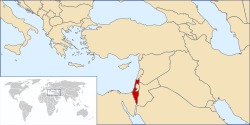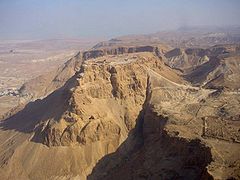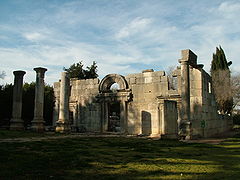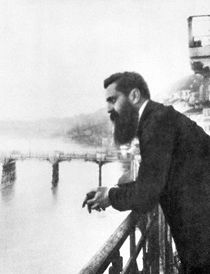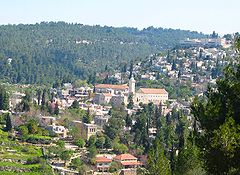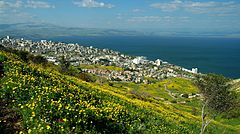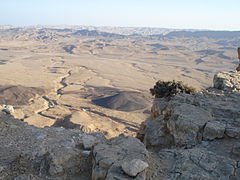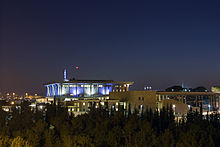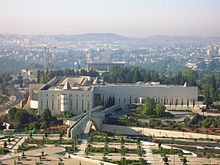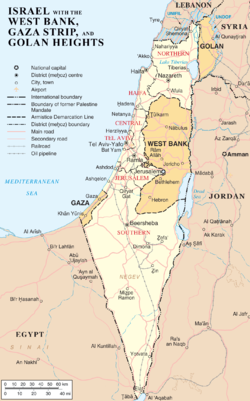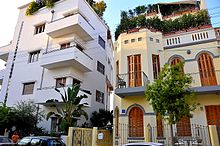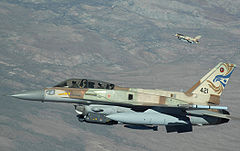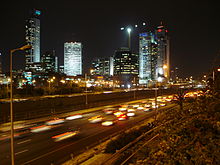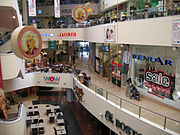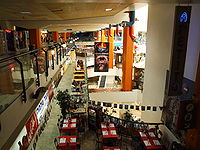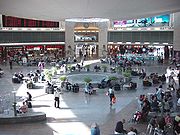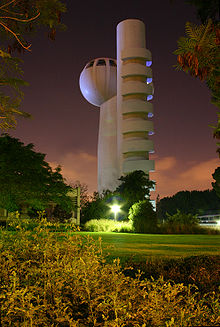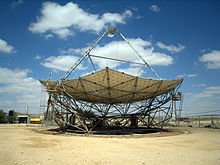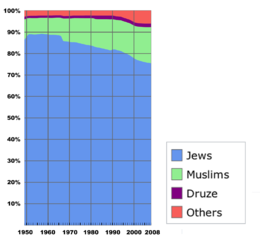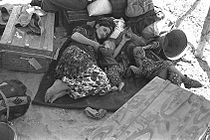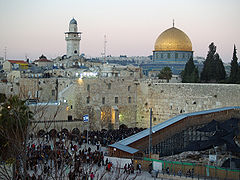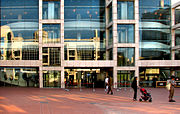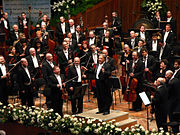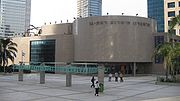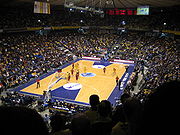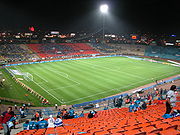- Israel
-
State of Israel מְדִינַת יִשְׂרָאֵל
Medīnat Yisrā'el
دَوْلَة إِسْرَائِيل
Dawlat Isrāʼīl

Flag Emblem Anthem:
Hatikvah (הַתִּקְוָה)Capital
(and largest city)Jerusalem[a]
31°47′N 35°13′E / 31.783°N 35.217°EOfficial language(s) Hebrew, Arabic[1] Ethnic groups 75.3% Jewish
20.5% Arab
4.2% other[2]Demonym Israeli Government Parliamentary democracy[1] - President Shimon Peres - Prime Minister Benjamin Netanyahu - Knesset Speaker Reuven Rivlin - Supreme Court President Dorit Beinisch Legislature Knesset Independence from British Mandate for Palestine - Declaration 14 May 1948 Area - Total 1 20,770 / 22,072 km2 (151st)
8,019 / 8,522 sq mi- Water (%) ~2% Population - 2011 estimate 7,798,600[2] (97th) - 2008 census 7,406,900[3] - Density 365.3/km2 (30th)
946.1/sq miGDP (PPP) 2011 estimate - Total $235.446 billion[4] (50) - Per capita $31,004[4] (28) GDP (nominal) 2011 estimate - Total $245.266 billion[4] (41) - Per capita $32,297[4] (27) Gini (2008) 39.2[1] HDI (2011)  0.888[5] (very high) (17th)
0.888[5] (very high) (17th)Currency Shekel (₪) ( ILS)Time zone IST (UTC+2) - Summer (DST) IDT (UTC+3) Drives on the right ISO 3166 code IL Internet TLD .il Calling code 972 1 Excluding / Including the Golan Heights and East Jerusalem; see below. 2 Includes all permanent residents in Israel, the Golan Heights and East Jerusalem. Also includes Israeli citizens living in the West Bank. Excludes non-Israeli population in the West Bank and the Gaza Strip. The State of Israel (Hebrew:
 מְדִינַת יִשְׂרָאֵל (help·info), Medīnat Yisrā'el, IPA: [me̞diˈnät jisʁäˈʔe̞l]; Arabic: دَوْلَة إِسْرَائِيل Dawlat Isrāʼīl, IPA: [dawlat ʔisraːˈʔiːl]) is a parliamentary republic located in the Middle East, along the eastern shore of the Mediterranean Sea. It borders Lebanon in the north, Syria in the northeast, Jordan and the West Bank in the east, Egypt and the Gaza Strip on the southwest, and contains geographically diverse features within its relatively small area.[6][7] Israel is defined as a Jewish and democratic state in its Basic Laws and is the world's only Jewish-majority state.[8]
מְדִינַת יִשְׂרָאֵל (help·info), Medīnat Yisrā'el, IPA: [me̞diˈnät jisʁäˈʔe̞l]; Arabic: دَوْلَة إِسْرَائِيل Dawlat Isrāʼīl, IPA: [dawlat ʔisraːˈʔiːl]) is a parliamentary republic located in the Middle East, along the eastern shore of the Mediterranean Sea. It borders Lebanon in the north, Syria in the northeast, Jordan and the West Bank in the east, Egypt and the Gaza Strip on the southwest, and contains geographically diverse features within its relatively small area.[6][7] Israel is defined as a Jewish and democratic state in its Basic Laws and is the world's only Jewish-majority state.[8]Following the 1947 United Nations decision to partition Palestine, on 14 May 1948 David Ben-Gurion, the Executive Head of the World Zionist Organization[9] and president of the Jewish Agency for Palestine, declared Israel a state independent from the British Mandate for Palestine.[10][11] Neighboring Arab states invaded the next day in support of the Palestinian Arabs. Israel has since fought several wars with neighboring Arab states,[12] in the course of which it has occupied the West Bank, Sinai Peninsula, Gaza Strip and Golan Heights. Portions of these territories, including Jerusalem, have been annexed by Israel but the border with the neighboring West Bank is still not formally defined.[13][14][15][16][17] Israel has signed peace treaties with Egypt and Jordan, but efforts to resolve the Israeli–Palestinian have so far not resulted in peace.
The population of Israel, defined by the Israel Central Bureau of Statistics to include all citizens or nationals, but not foreign workers, within Israel itself and in the Israeli settlements in the occupied territories, was estimated in June 2011 to be 7,751,000 people,[18] of whom 5,818,200 are Jewish.[18][19][20] Arabs form the country's second-largest ethnic group, which includes both Muslims and Christians. Other minorities are Druze, Circassians and Samaritans. At the end of 2005, 93% of the Arab population of East Jerusalem had permanent residency and 5% had Israeli citizenship.[21] In the Golan Heights, Druze are entitled to citizenship but most have rejected it in favor of "loyalty to Syria."[22]
Israel is a developed country and a representative democracy with a parliamentary system and universal suffrage.[23][24] The Prime Minister serves as head of government and the Knesset serves as Israel's unicameral legislative body. Israel has one of the highest life expectancies in the world.[25] The economy, based on the nominal gross domestic product, was the 42nd-largest in the world in 2010,[26] and has a very high rating on the Human Development Index.[5] Jerusalem is the country's capital, although it is not recognized internationally as such.[a] In 2010, Israel joined the OECD.[27]
Contents
Etymology
Upon independence in 1948, the new Jewish state was formally named Medinat Yisrael, or the State of Israel, after other proposed historical and religious names including Eretz Israel ("the Land of Israel"), Zion, and Judea, were considered and rejected.[28] In the early weeks of independence, the government chose the term "Israeli" to denote a citizen of Israel, with the formal announcement made by Minister of Foreign Affairs Moshe Sharett.[29]
The name Israel has historically been used, in common and religious usage, to refer to the biblical Kingdom of Israel or the entire Jewish nation.[30] According to the Hebrew Bible the name "Israel" was given to the patriarch Jacob (Standard Yisraʾel, Isrāʾīl; Septuagint Greek: Ἰσραήλ; "struggle with God"[31]) after he successfully wrestled with an angel of God.[32] Jacob's twelve sons became the ancestors of the Israelites, also known as the Twelve Tribes of Israel or Children of Israel. Jacob and his sons had lived in Canaan but were forced by famine to go into Egypt for four generations until Moses, a great-great grandson of Jacob,[33] led the Israelites back into Canaan in the "Exodus". The earliest archaeological artifact to mention the word "Israel" is the Merneptah Stele of ancient Egypt (dated to the late 13th century BCE).[34]
The area is also known as the Holy Land, being holy for all Abrahamic religions including Judaism, Christianity, Islam and the Bahá'í Faith. Prior to the 1948 Israeli Declaration of Independence, the whole region was known by various other names including Southern Syria, Syria Palestina, Kingdom of Jerusalem, Iudaea Province, Coele-Syria, Retjenu, Canaan and, particularly, Palestine.
History
Antiquity
Further information: History of ancient Israel and Judah, History of Israel, and History of PalestineThe notion of the "Land of Israel", known in Hebrew as Eretz Yisrael (or Eretz Yisroel), has been important and sacred to the Jewish people since Biblical times. According to the Torah, God promised the land to the three Patriarchs of the Jewish people.[37][38] On the basis of scripture, the period of the three Patriarchs has been placed somewhere in the early 2nd millennium BCE,[39] and the first Kingdom of Israel was established around the 11th century BCE. Subsequent Israelite kingdoms and states ruled intermittently over the next four hundred years, and are known from various extra-biblical sources.[40][41][42][43]
Between the fall of the northern Kingdom of Israel in 722 BCE and the Muslim conquests of the 7th century CE (a period of over 1500 years), the region came under Assyrian, Babylonian, Persian, Greek, Roman, Sassanid, and Byzantine rule.[44][45] Jewish presence in the region significantly dwindled after the failure of the Bar Kokhba revolt against the Roman Empire in 132 CE.[46] Nevertheless, there was a continuous small Jewish presence and Galilee became its religious center.[47][48] The Mishnah and part of the Talmud, central Jewish texts, were composed during the 2nd to 4th centuries CE in Tiberias and Jerusalem.[49] In 635 CE, the region, including Jerusalem, was conquered by the Arabs and was to remain under Muslim control for the next 1300 years.[50] Control of the region transferred between the Umayyads,[50] Abbasids,[50] and Crusaders throughout the next six centuries,[50] before being conquered by the Mamluk Sultanate, in 1260.[51] In 1516, the region was conquered by the Ottoman Empire, and remained under Turkish rule until the 20th century.[51]
Zionism and the British mandate
Aliyah to Israel
and settlement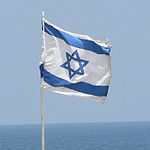
Pre-Zionist Aliyah The Return to Zion
Old YishuvBefore May 14, 1948 First Aliyah · Second Aliyah
During World War I
Third Aliyah · Fourth Aliyah
Fifth Aliyah
During and after World War II
BrichaAfter May 14, 1948 Operation Magic Carpet
Operation Ezra and Nehemiah
1968 Polish aliyah
1970s Soviet Union aliyah
Aliyah from Ethiopia
1990s CIS aliyah
2000s Latin America aliyahConcepts Judaism · Zionism
Jewish homeland
Jewish messianism
Law of Return
Galut · YeridaPersons and
organizationsTheodor Herzl · Knesset
El Al · Nefesh B'Nefesh
World Zionist OrganizationRelated topics History of Israel
History of Zionism
Israeli Jews
Jewish diaspora
Jewish history
Jews in the Land of Israel
Religious Zionism
Revival of the Hebrew language · YishuvFurther information: History of ZionismSince the Diaspora, many Jews long aspired to return to "Zion" and the "Land of Israel",[52] though the amount of effort that should be spent towards such an aim was a matter of dispute.[53][54] The hopes and yearnings of Jews living in exile was articulated in the Hebrew Bible,[55] and is an important theme of the Jewish belief system.[53] After the Jews were expelled from Spain in 1492, some communities settled in Palestine.[56] During the 16th century, Jewish communities struck roots in the Four Holy Cities—Jerusalem, Tiberias, Hebron, and Safed—and in 1697, Rabbi Yehuda Hachasid led a group of 1,500 Jews to Jerusalem.[57] In the second half of the 18th century, Eastern European opponents of Hasidism, known as the Perushim, settled in Palestine.[58][59][60]
The first wave of modern Jewish migration to Ottoman-ruled Palestine, known as the First Aliyah, began in 1881, as Jews fled pogroms in Eastern Europe.[61] Although the Zionist movement already existed in practice, Austro-Hungarian journalist Theodor Herzl is credited with founding political Zionism,[62] a movement which sought to establish a Jewish state in the Land of Israel, by elevating the Jewish Question to the international plane.[63] In 1896, Herzl published Der Judenstaat (The State of the Jews), offering his vision of a future Jewish state; the following year he presided over the first World Zionist Congress.[64]
The Second Aliyah (1904–14), began after the Kishinev pogrom; some 40,000 Jews settled in Palestine, although nearly half of them later left.[61] Both the first and second waves of migrants were mainly Orthodox Jews,[65] although the Second Aliyah included socialist groups who established the kibbutz movement.[66] During World War I, British Foreign Secretary Arthur Balfour sent a letter that stated:[67]
His Majesty's government view with favour the establishment in Palestine of a national home for the Jewish people, and will use their best endeavours to facilitate the achievement of this object, it being clearly understood that nothing shall be done which may prejudice the civil and religious rights of existing non-Jewish communities in Palestine, or the rights and political status enjoyed by Jews in any other country."[68]The Jewish Legion, a group primarily of Zionist volunteers, assisted in the British conquest of Palestine in 1917. Arab opposition to British rule and Jewish immigration led to the 1920 Palestine riots and the formation of a Jewish militia known as the Haganah (meaning "The Defense" in Hebrew), from which the Irgun and Lehi, or Stern Gang, paramilitary groups later split off.[69] In 1922, the League of Nations granted Britain a mandate over Palestine under terms similar to the Balfour Declaration.[70] The population of the area at this time was predominantly Arab and Muslim, with Jews accounting for about 11% of the population.[71]
The Third (1919–1923) and Fourth Aliyahs (1924–1929) brought an additional 100,000 Jews to Palestine.[61] Finally, the rise of Nazism and the increasing persecution of Jews in the 1930s led to the Fifth Aliyah, with an influx of a quarter of a million Jews. This was a major cause of the Arab revolt of 1936–1939 and led the British to introduce restrictions on Jewish immigration to Palestine with the White Paper of 1939. With countries around the world turning away Jewish refugees fleeing the Holocaust, a clandestine movement known as Aliyah Bet was organized to bring Jews to Palestine.[61] By the end of World War II, the Jewish population of Palestine had increased to 33% of the total population.[72]
Independence and first years
After World War II, Britain found itself in fierce conflict with the Jewish community, as the Haganah joined Irgun and Lehi in an armed struggle against British rule.[73] At the same time, thousands of Jewish Holocaust survivors and refugees from Europe sought a new life in Palestine, but were turned away or rounded up and placed in detention camps by the British. In 1947, the British government announced it would withdraw from the Mandate of Palestine, stating it was unable to arrive at a solution acceptable to both Arabs and Jews.[74] The newly created United Nations approved the Partition Plan for Palestine (United Nations General Assembly Resolution 181) on 29 November 1947, which sought to divide the country into two states—one Arab and one Jewish. Jerusalem was designated to be an international city—a corpus separatum—administered by the UN.[75]
The Jewish community accepted the plan,[76] but the Arab League and Arab Higher Committee of Palestine rejected it.[77] On 1 December 1947, the Arab Higher Committee proclaimed a three-day strike, and Arab bands began attacking Jewish targets.[78] The Jews were initially on the defensive as civil war broke out, but gradually moved onto the offensive.[79] The Palestinian Arab economy collapsed and 250,000 Palestinian-Arabs fled or were expelled.[80]
 David Ben-Gurion proclaiming Israeli independence on 14 May 1948, below a portrait of Theodor Herzl in the Tel Aviv Museum of Art, now Israel's Independence Hall
David Ben-Gurion proclaiming Israeli independence on 14 May 1948, below a portrait of Theodor Herzl in the Tel Aviv Museum of Art, now Israel's Independence Hall
On 14 May 1948, the day before the expiration of the British Mandate, the Jewish Agency proclaimed independence, naming the country Israel.[81] The following day, the armies of four Arab countries —Egypt, Syria, Lebanon and Iraq – attacked Israel, launching the 1948 Arab–Israeli War;[82][83] Saudi Arabia sent a military contingent to operate under Egyptian command; Yemen declared war but did not take military action.[84] After a year of fighting, a ceasefire was declared and temporary borders, known as the Green Line, were established.[85] Jordan annexed what became known as the West Bank and East Jerusalem, and Egypt took control of the Gaza Strip. The United Nations estimated that more than 700,000 Palestinians were expelled or fled from what would become Israel during the conflict.[86]
Israel was accepted as a member of the United Nations by majority vote on 11 May 1949.[87]
In the early years of the state, the Labor Zionist movement led by Prime Minister David Ben-Gurion dominated Israeli politics.[88][89] These years were marked by an influx of Holocaust survivors and Jews from Arab lands, many of whom faced persecution in and expulsion from their original countries.[90] Consequently, the population of Israel rose from 800,000 to two million between 1948 and 1958.[91] Between 1948–1970, approximately 1,151,029 Jewish refugees relocated to Israel.[92] Some arrived as refugees with no possessions and were housed in temporary camps known as ma'abarot; by 1952, over 200,000 immigrants were living in these tent cities.[93] The need to solve the crisis led Ben-Gurion to sign a reparations agreement with West Germany that triggered mass protests by Jews angered at the idea that Israel could accept monetary compensation for the Holocaust.[94]
In the 1950s, Israel was frequently attacked by Palestinian fedayeen, mainly from the Egyptian-occupied Gaza Strip.[95] In 1950 Egypt closed the Suez Canal to Israeli shipping and tensions mounted as armed clashes took place along Israel's borders. In 1956, Israel joined a secret alliance with Great Britain and France aimed at regaining control of the Suez Canal, which the Egyptians had nationalized (see the Suez Crisis). Israel overran the Sinai Peninsula but was pressured to withdraw by the United Nations in return for guarantees of Israeli shipping rights in the Red Sea and the Canal.[96][97]
In the early 1960s, Israel captured Nazi war criminal Adolf Eichmann in Argentina and brought him to Israel for trial.[98] The trial had a major impact on public awareness of the Holocaust.[99] Eichmann remains the only person ever to be executed by an Israeli court.[100]
Conflicts and peace treaties
Further information: Arab–Israeli conflict, Israeli–Palestinian conflict, and Positions on Jerusalem Paratroopers of the 35th Brigade at Jerusalem's Western Wall following its capture during the Six-Day War, 1967
Paratroopers of the 35th Brigade at Jerusalem's Western Wall following its capture during the Six-Day War, 1967
Arab nationalists led by Egyptian President Gamal Abdel Nasser continued to refuse to recognize Israel, and called for its destruction.[12][101] By 1966, Israeli-Arab relations had deteriorated to the point of actual battles taking place between Israeli and Arab forces.[102] In 1967, Egypt expelled UN peacekeepers, stationed in the Sinai Peninsula since 1957, and announced a partial blockade of Israel's access to the Red Sea. In May 1967 a number of Arab states began to mobilize their forces.[103] Israel saw these actions as a casus belli. On 5 June 1967, Israel launched a pre-emptive strike against Egypt, Jordan, Syria and Iraq. In a Six-Day War, Israeli military superiority was clearly demonstrated against their more numerous Arab foes. Israel succeeded in capturing the West Bank, the Gaza Strip, Sinai Peninsula and the Golan Heights.[104] Jerusalem's boundaries were enlarged, incorporating East Jerusalem, and the 1949 Green Line became the administrative boundary between Israel and the occupied territories.
In the Six-Day War of 1967, Israel defeated the combined armies of Egypt, Jordan and Syria. Following the war, Israel faced much internal resistance from the Arab Palestinians. Most important among the various Palestinian and Arab groups was the Palestinian Liberation Organization (PLO), established in 1964, which initially committed itself to "armed struggle as the only way to liberate the homeland".[105][106] In the late 1960s and early 1970s, Palestinian groups launched a wave of attacks[107][108] against Israel and Jewish targets around the world,[109] including a massacre of Israeli athletes at the 1972 Summer Olympics in Munich.
On 6 October 1973, as Jews were observing Yom Kippur, the Egyptian and Syrian armies launched a surprise attack against Israel. The war ended on 26 October with Israel successfully repelling Egyptian and Syrian forces but suffering significant losses.[110] An internal inquiry exonerated the government of responsibility for failures before and during the war, but public anger forced Prime Minister Golda Meir to resign.[111]
In July 1976 Israeli commandos carried out a daring mission which succeeded in rescuing 95 hostages who were being held by PLO guerillas at Entebbe International Airport close to Kampala, Uganda.
The 1977 Knesset elections marked a major turning point in Israeli political history as Menachem Begin's Likud party took control from the Labor Party.[112] Later that year, Egyptian President Anwar El Sadat made a trip to Israel and spoke before the Knesset in what was the first recognition of Israel by an Arab head of state.[113] In the two years that followed, Sadat and Menachem Begin signed the Camp David Accords (1978) and the Israel–Egypt Peace Treaty (1979).[114] Israel withdrew from the Sinai Peninsula and agreed to enter negotiations over an autonomy for Palestinians in the West Bank and the Gaza Strip.[115]
On 11 March 1978, a PLO guerilla raid from Lebanon led to the Coastal Road Massacre, in which 35 Israeli civilians were killed and 75 injured. Israel responded by launching an invasion of southern Lebanon to destroy the PLO bases south of the Litani River. Most PLO fighters withdrew, but Israel was able to secure southern Lebanon until a UN force and the Lebanese army could take over. However, the PLO soon resumed its policy of resistance to Israel. In the next few years the PLO infiltrated back south and kept up a sporadic shelling across the border. Israel carried out numerous retaliatory attacks by air and on the ground.
Meanwhile, Begin's government actively encouraged Israelis to settle in the occupied West Bank, leading to increasing friction with the Palestinians in that area.[116]
The Basic Law: Jerusalem, the Capital of Israel, passed in 1980, was believed by some to reaffirm Israel's 1967 annexation of Jerusalem by government decree and reignited international controversy over the status of the city. However, there has never been an Israeli government act which defined what it considers to be the extent of the territory of Israel and no act which specifically included East Jerusalem therein.[117] The position of the majority of UN member states is reflected in numerous resolutions declaring that actions taken by Israel to settle its citizens in the West Bank, and impose its laws and administration on East Jerusalem are illegal and have no validity.[118]
On 7 June 1981, the Israeli air force destroyed Iraq's sole nuclear power plant, which was under construction just outside Baghdad.
Following a series of PLO attacks in 1982, Israel invaded Lebanon once again to destroy the bases from which the PLO launched attacks and missiles into northern Israel First Lebanon War.[119] In the first six days of fighting, the Israelis destroyed the military forces of the PLO in Lebanon and decisively defeated the Syrians. An Israeli government inquiry – the Kahan Commission – would later hold Begin, Sharon and several Israeli generals as indirectly responsible for the Sabra and Shatila massacres. In 1985 Israel responded to a PLO terrorist attack in Cyprus by bombing the PLO headquarters in Tunis. Israel withdrew from most of Lebanon in 1986, but maintained a borderland buffer zone in southern Lebanon until 2000. The First Intifada, a Palestinian uprising against Israeli rule,[120] broke out in 1987 with waves of uncoordinated demonstrations and violence occurring in the occupied West Bank and Gaza. Over the following six years, the Intifada became more organised and included economic and cultural measures aimed at disrupting the Israeli occupation. More than a thousand people were killed in the violence, many of them stone-throwing youths.[121] Responding to continuing PLO guerilla raids into northern Israel, Israel launched another punitive raid into southern Lebanon in 1988. Amid rising tensions over the Kuwait crisis, Israeli border guards fired into a rioting Palestinian crowd near the Al-Aqsa mosque in Jerusalem. 20 people were killed and some 150 injured. During the 1991 Gulf War, the PLO supported Saddam Hussein and Iraqi Scud missile attacks against Israel. Despite public outrage, Israel heeded US calls to refrain from hitting back and did not participate in that war.[122][123]
In 1992, Yitzhak Rabin became Prime Minister following an election in which his party called for compromise with Israel's neighbors.[124][125] The following year, Shimon Peres on behalf of Israel, and Mahmoud Abbas for the PLO, signed the Oslo Accords, which gave the Palestinian National Authority the right to govern parts of the West Bank and the Gaza Strip.[126] The PLO also recognized Israel's right to exist and pledged an end to terrorism.[127] In 1994, the Israel-Jordan Treaty of Peace was signed, making Jordan the second Arab country to normalize relations with Israel.[128] Arab public support for the Accords was damaged by the continuation of Israeli settlements[129] and checkpoints, and the deterioration of economic conditions.[130] Israeli public support for the Accords waned as Israel was struck by Palestinian suicide attacks.[131] Finally, while leaving a peace rally in November 1995, Yitzhak Rabin was assassinated by a far-right-wing Jew who opposed the Accords.[132]
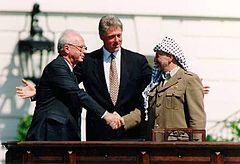 Yitzhak Rabin and Yasser Arafat shake hands at the signing of the Oslo Accords, with Bill Clinton behind them, 1993
Yitzhak Rabin and Yasser Arafat shake hands at the signing of the Oslo Accords, with Bill Clinton behind them, 1993
At the end of the 1990s, Israel, under the leadership of Benjamin Netanyahu, withdrew from Hebron,[133] and signed the Wye River Memorandum, giving greater control to the Palestinian National Authority.[134] Ehud Barak, elected Prime Minister in 1999, began the new millennium by withdrawing forces from Southern Lebanon and conducting negotiations with Palestinian Authority Chairman Yasser Arafat and U.S. President Bill Clinton at the 2000 Camp David Summit. During the summit, Barak offered a plan for the establishment of a Palestinian state, but Yasser Arafat rejected it.[135] After the collapse of the talks and a controversial visit by Likud leader Ariel Sharon to the Temple Mount, the Second Intifada began. Sharon became prime minister in a 2001 special election. During his tenure, Sharon carried out his plan to unilaterally withdraw from the Gaza Strip and also spearheaded the construction of the Israeli West Bank barrier.[136]
In July 2006, a Hezbollah artillery assault on Israel's northern border communities and a cross-border abduction of two Israeli soldiers sparked the month-long Second Lebanon War.[137][138] Two years later, in May 2008, Israel confirmed it had been discussing a peace treaty with Syria for a year, with Turkey as a go-between.[139] However, at the end of the year, Israel entered another conflict as a ceasefire between Hamas and Israel collapsed. The Gaza War lasted three weeks and ended after Israel announced a unilateral ceasefire.[140][141] Hamas announced its own ceasefire, with its own conditions of complete withdrawal and opening of border crossings. Despite neither the rocket launchings nor Israeli retaliatory strikes having completely stopped, the fragile ceasefire remained in order.[142]
Geography and climate
Israel is located at the eastern end of the Mediterranean Sea, bounded by Lebanon to the north, Syria to the northeast, Jordan to the east, and Egypt to the southwest. It lies between latitudes 29° and 34° N, and longitudes 34° and 36° E.
The sovereign territory of Israel, excluding all territories captured by Israel during the 1967 Six-Day War, is approximately 20,770 square kilometers (8,019 sq mi) in area, of which two percent is water.[1] The total area under Israeli law, when including East Jerusalem and the Golan Heights, is 22,072 square kilometers (8,522 sq mi),[143] and the total area under Israeli control, including the military-controlled and partially Palestinian-governed territory of the West Bank, is 27,799 square kilometers (10,733 sq mi).[144] Despite its small size, Israel is home to a variety of geographic features, from the Negev desert in the south to the mountain ranges of the Galilee, Carmel and toward the Golan in the north. The Israeli Coastal Plain on the shores of the Mediterranean is home to seventy percent of the nation's population. East of the central highlands lies the Jordan Rift Valley, which forms a small part of the 6,500-kilometer (4,039 mi) Great Rift Valley.
The Jordan River runs along the Jordan Rift Valley, from Mount Hermon through the Hulah Valley and the Sea of Galilee to the Dead Sea, the lowest point on the surface of the Earth.[145] Further south is the Arabah, ending with the Gulf of Eilat, part of the Red Sea. Unique to Israel and the Sinai Peninsula are makhteshim, or erosion cirques.[146] The largest makhtesh in the world is Ramon Crater in the Negev,[147] which measures 40 by 8 kilometers (25 by 5 mi).[148] A report on the environmental status of the Mediterranean basin states that Israel has the largest number of plant species per square meter of all the countries in the basin.[149]
Temperatures in Israel vary widely, especially during the winter. The more mountainous regions can be windy, cold, and sometimes snowy; Jerusalem usually receives at least one snowfall each year.[150] Meanwhile, coastal cities, such as Tel Aviv and Haifa, have a typical Mediterranean climate with cool, rainy winters and long, hot summers. The area of Beersheba and the Northern Negev has a semi-arid climate with hot summers, and cool winter but with fewer rainy than the Mediterranean climate. The Southern Negev and the Arava areas have Desert climate with very hot and dry summers, and mild winters with few days of rain. The highest temperature in the continent of Asia (53.7 °C/128.7 °F) was recorded in 1942 at Tirat Zvi kibbutz in the northern Jordan river valley.[151]
From May to September, rain in Israel is rare.[152][153] With scarce water resources, Israel has developed various water-saving technologies, including drip irrigation.[154] Israelis also take advantage of the considerable sunlight available for solar energy, making Israel the leading nation in solar energy use per capita (practically every house uses solar panels for water heating).[155]
Four different phytogeographic regions exist in Israel, due to the country's location between the temperate and the tropical zones, bordering the Mediterranean Sea in the west and the desert in the east. For this reason the flora and fauna of Israel is extremely diverse.
There are 2,867 known species of plants found in Israel. Of these, at least 253 species are introduced and non-native.[156] As of May 2007, there are 190 Israeli nature reserves.[157]
Politics
Israel operates under a parliamentary system as a democratic republic with universal suffrage.[1] A member of parliament supported by a parliamentary majority becomes the prime minister—usually this is the chair of the largest party. The prime minister is the head of government and head of the cabinet.[158][159] Israel is governed by a 120-member parliament, known as the Knesset. Membership of the Knesset is based on proportional representation of political parties,[160] with a 2% electoral threshold, which in practice has resulted in coalition governments.
Parliamentary elections are scheduled every four years, but unstable coalitions or a no-confidence vote by the Knesset can dissolve a government earlier. The Basic Laws of Israel function as an uncodified constitution. In 2003, the Knesset began to draft an official constitution based on these laws.[1][161]
The president of Israel is head of state, with limited and largely ceremonial duties.[158]
Legal system
Israel has a three-tier court system. At the lowest level are magistrate courts, situated in most cities across the country. Above them are district courts, serving both as appellate courts and courts of first instance; they are situated in five of Israel's six districts. The third and highest tier is the Supreme Court, located in Jerusalem; it serves a dual role as the highest court of appeals and the High Court of Justice. In the latter role, the Supreme Court rules as a court of first instance, allowing individuals, both citizens and non-citizens, to petition against the decisions of state authorities.[162][163] Although Israel supports the goals of the International Criminal Court, it has not ratified the Rome Statute, citing concerns about the ability of the court to remain free from political impartiality.[164]
Israel's legal system combines three legal traditions: English common law, civil law, and Jewish law.[1] It is based on the principle of stare decisis (precedent) and is an adversarial system, where the parties in the suit bring evidence before the court. Court cases are decided by professional judges rather than juries.[162] Marriage and divorce are under the jurisdiction of the religious courts: Jewish, Muslim, Druze, and Christian. A committee of Knesset members, Supreme Court justices, and Israeli Bar members carries out the election of judges.[165] Administration of Israel's courts (both the "General" courts and the Labor Courts) is carried by the Administration of Courts, situated in Jerusalem. Both General and Labor courts are paperless courts: the storage of court files, as well as court decisions, are conducted electronically.
Israel's Basic Law: Human Dignity and Liberty seeks to defend human rights and liberties in Israel. Israel is the only country in the region ranked "Free" by Freedom House based on the level of civil liberties and political rights; the "Israeli Occupied Territories/Palestinian Authority" was ranked "Not Free."[166][167] In 2010, Israel proper was ranked 86th according to Reporters Without Borders' Press Freedom Index - the second highest ranking in the region, after Lebanon at 78.[168]
Administrative divisions
The State of Israel is divided into six main administrative districts, known as mehozot (מחוזות; singular: mahoz) – Center, Haifa, Jerusalem, North, Southern, and Tel Aviv Districts. Districts are further divided into fifteen sub-districts known as nafot (נפות; singular: nafa), which are themselves partitioned into fifty natural regions.[169]
Number District Main city Sub-district Population 1 North Nazareth Kinneret, Safed, Acre, Golan, Jezreel Valley 1,242,100 2 Haifa Haifa Haifa, Hadera 880,000 3 Center Ramla Rishon Lezion, Sharon (Netanya), Petah Tikva, Ramla, Rehovot 1,770,200 4 Tel Aviv Tel Aviv Tel Aviv 1,227,000 5 Jerusalem Jerusalem Jerusalem 910,300 6 South Beersheba Ashkelon, Beersheba 1,053,600 A Golan Heights Katzrin 38,900 B Judea and Samaria Modi'in Illit (Largest "settlement"/city) West Bank 304,569[170] C Gaza Strip Gaza Gaza, Rafah 1,657,155 [171] For statistical purposes, the country is divided into three metropolitan areas: Tel Aviv metropolitan area (population 3,206,400), Haifa metropolitan area (population 1,021,000), and Beer Sheva metropolitan area (population 559,700).[172] Israel's largest municipality, both in population and area,[173] is Jerusalem with 773,800 residents in an area of 126 square kilometers (49 sq mi) (in 2009).
Israeli government statistics on Jerusalem include the population and area of East Jerusalem, which is widely recognized as part of the Palestinian territories under Israeli occupation.[174] Tel Aviv, Haifa, and Rishon LeZion rank as Israel's next most populous cities, with populations of 393,900, 265,600, and 227,600 respectively.[173]
Israeli-occupied territories
In 1967, as a result of the Six-Day War, Israel gained control of the West Bank (Judaea and Samaria), East Jerusalem, the Gaza strip and the Golan Heights. Israel also took control of the Sinai Peninsula, but returned it to Egypt as part of the 1979 Israel-Egypt Peace Treaty.Following Israel's capture of these territories, settlements consisting of Israeli citizens were established within each of them. Israel applied civilian law to the Golan Heights and East Jerusalem, incorporating them into its sovereign territory and granting their inhabitants permanent residency status and the choice to apply for citizenship. In contrast, the West Bank has remained under military occupation, and Palestinians in this area cannot become citizens. The Gaza Strip is independent of Israel with no Israeli military or civilian presence, but Israel continues to maintain control of its airspace and waters. The Gaza Strip and the West Bank are seen by the Palestinians and most of the international community as the site of a future Palestinian state.[175][176] The UN Security Council has declared the annexation of the Golan Heights and East Jerusalem to be "null and void" and continues to view the territories as occupied.[177][178] The International Court of Justice, principal judicial organ of the United Nations, asserted, in its 2004 advisory opinion on the legality of the construction of the Israeli West Bank barrier, that the lands captured by Israel in the Six-Day War, including East Jerusalem, are occupied territory.[179]
The status of East Jerusalem in any future peace settlement has at times been a difficult hurdle in negotiations between Israeli governments and representatives of the Palestinians, as Israel views it as its sovereign territory, as well as part of its capital. Most negotiations relating to the territories have been on the basis of United Nations Security Council Resolution 242, which emphasises "the inadmissibility of the acquisition of territory by war", and calls on Israel to withdraw from occupied territories in return for normalization of relations with Arab states, a principle known as "Land for peace".[180][181][182]
The West Bank was annexed by Jordan in 1948, following the Arab rejection of the UN decision to create two states in Palestine. Only Britain recognized this annexation and Jordan has since ceded its claim to the territory to the PLO. The West Bank was occupied by Israel in 1967. The population are mainly Arab Palestinians, including refugees of the 1948 Arab-Israeli War.[183] From their occupation in 1967 until 1993, the Palestinians living in these territories were under Israeli military administration. Since the Israel-PLO letters of recognition, most of the Palestinian population and cities have been under the internal jurisdiction of the Palestinian Authority, and only partial Israeli military control, although Israel has on several occasions redeployed its troops and reinstated full military administration during periods of unrest. In response to increasing attacks as part of the Second Intifada, the Israeli government started to construct the Israeli West Bank barrier.[184] When completed, approximately 13 % of the Barrier will be constructed on the Green Line or in Israel with 87 % inside the West Bank.[185][186]
The Gaza Strip was occupied by Egypt from 1948 to 1967 and then by Israel after 1967. In 2005, as part of Israel's unilateral disengagement plan, Israel removed all of its settlers and forces from the territory. Israel does not consider the Gaza Strip to be occupied territory and declared it a "foreign territory". That view has been disputed by numerous international humanitarian organizations and various bodies of the United Nations.[187][188][189][190][191] Following June 2007, when Hamas assumed power in the Gaza Strip,[192] Israel tightened its control of the Gaza crossings along its border, as well as by sea and air, and prevented persons from entering and exiting the area except for isolated cases it deemed humanitarian.[192] Gaza has a border with Egypt and an agreement between Israel, the European Union and the PA governed how border crossing would take place (it was monitored by European observers),[193] Egypt adhered to this agreement under Mubarak and prevented access to Gaza until April 2011 when it announced it was opening its border with Gaza.
Foreign relations
Israel maintains diplomatic relations with 157 countries and has 100 diplomatic missions around the world.[196] Only three members of the Arab League have normalized relations with Israel; Egypt and Jordan signed peace treaties in 1979 and 1994, respectively, and Mauritania opted for full diplomatic relations with Israel in 1999. Despite the peace treaty between Israel and Egypt, Israel is still widely considered an enemy country among Egyptians.[197] Under Israeli law, Lebanon, Syria, Saudi Arabia, Iraq, and Yemen are enemy countries[198] and Israeli citizens may not visit them without permission from the Ministry of the Interior.[199]
The Soviet Union and the United States were the first two countries to recognize the State of Israel, having declared recognition roughly simultaneously. The United States may regard Israel as its primary ally in the Middle East, based on "common democratic values, religious affinities, and security interests".[200] The United States has provided $68 billion in military assistance and $32 billion in grants to Israel since 1967, under the Foreign Assistance Act (period beginning 1962),[201] more than any other country for that period until 2003.[201][202] Their bilateral relations are multidimensional and the United States is the principal proponent of the Arab-Israeli peace process. The United States and Israeli views differ on some issues, such as the Golan Heights, Jerusalem, and settlements.[203]
India established full diplomatic ties with Israel in 1992 and has fostered a strong military, technological and cultural partnership with the country since then.[204] According to an international opinion survey conducted in 2009 on behalf of the Israeli Foreign Ministry, India is the most pro-Israel country in the world.[205][206] India is the largest customer of Israeli military equipment and Israel is the second-largest military partner of India after the Russian Federation.[207] India is also the second-largest Asian economic partner of Israel[208] and the two countries enjoy extensive space technology ties.[209][210] India became the top source market for Israel from Asia in 2010 with 41,000 tourist arrivals in that year.[211]
Germany's strong ties with Israel include cooperation on scientific and educational endeavors and the two states remain strong economic and military partners.[212][213] Under the reparations agreement, as of 2007 Germany had paid 25 billion euros in reparations to the Israeli state and individual Israeli holocaust survivors.[214] The UK has kept full diplomatic relations with Israel since its formation having had two visits from heads of state in 2007. Relations between the two countries were also made stronger by former prime minister Tony Blair's efforts for a two state resolution. The UK is seen as having a "natural" relationship with Israel on account of the British Mandate for Palestine.[215] Iran had diplomatic relations with Israel under the Pahlavi dynasty[216] but withdrew its recognition of Israel during the Iranian Revolution.[217]
Although Turkey and Israel did not establish full diplomatic relations until 1991,[218] Turkey has cooperated with the State since its recognition of Israel in 1949. Turkey's ties to the other Muslim-majority nations in the region have at times resulted in pressure from Arab and Muslim states to temper its relationship with Israel.[219] Relations between Turkey and Israel took a downturn after the Gaza War and Israel's raid of the Gaza flotilla.[220] IHH, which organized the flotilla, is a Turkish charity that some believe has ties to Hamas and Al-Qaeda.[221][222][223][224][225]
In Africa, Ethiopia is Israel's main and closest ally in the continent due to common political, religious and security interests.[226] Israel provides expertise to Ethiopia on irrigation projects and thousands of Ethiopian Jews (Beta Israel) live in Israel.
As a result of the 2009 Gaza War, Mauritania, Qatar, Bolivia, and Venezuela suspended political and economical ties with Israel.[221][227]
Military
Main articles: Israel Defense Forces, Israeli security forces, Wars involving Israel, and military operations conducted by the Israel Defense ForcesIsrael has the highest ratio of defense spending to GDP and as a percentage of the budget of all developed countries.[228][229] The Israel Defense Forces consists of the Israeli Army, Israeli Air Force and Israeli Navy. It was founded during the 1948 Arab–Israeli War by consolidating paramilitary organizations—chiefly the Haganah—that preceded the establishment of the state.[230] The IDF also draws upon the resources of the Military Intelligence Directorate (Aman), which works with the Mossad and Shabak.[231] The Israel Defense Forces have been involved in several major wars and border conflicts in its short history, making it one of the most battle-trained armed forces in the world.[232][233]
Most Israelis are drafted into the military at the age of 18. Men serve three years and women two to three years.[234] Following mandatory service, Israeli men join the reserve forces and usually do up to several weeks of reserve duty every year until their forties. Most women are exempt from reserve duty. Arab citizens of Israel (except the Druze) and those engaged in full-time religious studies are exempt from military service, although the exemption of yeshiva students has been a source of contention in Israeli society for many years.[235][236] An alternative for those who receive exemptions on various grounds is Sherut Leumi, or national service, which involves a program of service in hospitals, schools and other social welfare frameworks.[237] As a result of its conscription program, the IDF maintains approximately 168,000 active troops and an additional 408,000 reservists.[238]
The nation's military relies heavily on high-tech weapons systems designed and manufactured in Israel as well as some foreign imports. Since 1967, the United States has been a particularly notable foreign contributor of military aid to Israel: the US is expected to provide the country with $3.15 billion per year from 2013–2018.[239][240] The Arrow missile is one of the world's only operational anti-ballistic missile systems.[241]
Since the Yom Kippur War, Israel has developed a network of reconnaissance satellites.[242] The success of the Ofeq program has made Israel one of seven countries capable of launching such satellites.[243] Since its establishment, Israel has spent a significant portion of its gross domestic product on defense. In 1984, for example, the country spent 24%[244] of its GDP on defense. Today, that figure has dropped to 7.3%.[1]
Israel is widely believed to possess nuclear weapons.[245] Israel has not signed the Nuclear Non-Proliferation Treaty[citation needed] and maintains a policy of deliberate ambiguity toward its nuclear capabilities.[246]
Since the Gulf War in 1991, when Israel was attacked by Iraqi Scud missiles, all homes in Israel are required to have a reinforced security room impermeable to chemical and biological substances.[247]
The IDF has also been deployed on humanitarian missions, usually involving rescue workers and medical personnel, along with relief workers and body identifiers from ZAKA and the Israel Police. After the 2010 Haiti earthquake, a rescue team was dispatched to Haiti, which consisted of 40 doctors, 20 nurses and rescue workers, and two rescue planes loaded with medical equipment and a field hospital with X-ray equipment, intensive care units, and operating rooms. Other recipients of aid include, Japan (a medical team after the 2011 tsunami), Congo 2008, Sri Lanka 2005 (tsunami), India and El Salvador 2001 (earthquakes), Ethiopia 2000, Turkey 1998 (earthquake), Kosovo 1999 (refugees) and Rwanda 1994 (refugees).[248]
Israel is consistently rated very low in the Global Peace Index, ranking 145th out of 153 nations for peacefulness in 2011.[249]
Economy
 Gulfstream G200 transcontinental business jet was designed and is currently produced for Gulfstream Aerospace by Israel Aircraft Industries (IAI)
Gulfstream G200 transcontinental business jet was designed and is currently produced for Gulfstream Aerospace by Israel Aircraft Industries (IAI)
Israel is considered one of the most advanced countries in Southwest Asia in economic and industrial development. In 2010, it joined the OECD.[27][250] The country is ranked 3rd in the region on the World Bank's Ease of Doing Business Index[251] as well as in the World Economic Forum's Global Competitiveness Report.[252] It has the second-largest number of startup companies in the world (after the United States)[253] and the largest number of NASDAQ-listed companies outside North America.[254]
In 2010, Israel ranked 17th among of the world's most economically developed nations, according to IMD's World Competitiveness Yearbook. The Israeli economy was ranked first as the world's most durable economy in the face of crises, and was also ranked first in the rate of research and development center investments.[255]
The Bank of Israel was ranked first among central banks for its efficient functioning, up from the 8th place in 2009. Israel was also ranked as the worldwide leader in its supply of skilled manpower.[255] The Bank of Israel holds $78 billion of foreign-exchange reserves.[256]
Despite limited natural resources, intensive development of the agricultural and industrial sectors over the past decades has made Israel largely self-sufficient in food production, apart from grains and beef. Other major imports to Israel, totaling $47.8 billion in 2006, include fossil fuels, raw materials, and military equipment.[1] Leading exports include electronics, software, computerized systems, communications technology, medical equipment, pharmaceuticals, fruits, chemicals, military technology, and cut diamonds;[257] in 2006, Israeli exports reached $42.86 billion,[1] and by 2010 they had reached $80.5 billion a year.[257]
Israel is a leading country in the development of solar energy.[258][259] Israel is a global leader in water conservation and geothermal energy,[260] and its development of cutting-edge technologies in software, communications and the life sciences have evoked comparisons with Silicon Valley.[261][262] According to the OECD, Israel is also ranked 1st in the world in expenditure on Research and Development (R&D) as a percentage of GDP.[263] Intel[264] and Microsoft[265] built their first overseas research and development centers in Israel, and other high-tech multi-national corporations, such as IBM, Cisco Systems, and Motorola, have opened facilities in the country. In July 2007, U.S. billionaire Warren Buffett's Berkshire Hathaway bought an Israeli company Iscar, its first non-U.S. acquisition, for $4 billion.[266] Since the 1970s, Israel has received military aid from the United States, as well as economic assistance in the form of loan guarantees, which now account for roughly half of Israel's external debt. Israel has one of the lowest external debts in the developed world, and is a net lender in terms of net external debt (the total value of assets vs. liabilities in debt instruments owed abroad), which as of June 2009 stood at a surplus of US$54 billion.[267][268]
Tourism
Tourism, especially religious tourism, is an important industry in Israel, with the country's temperate climate, beaches, archaeological and historical sites, and unique geography also drawing tourists. Israel's security problems have taken their toll on the industry, but the number of incoming tourists is on the rebound.[269] In 2008, over 3 million tourists visited Israel.[270] Israel has the highest number of museums per capita in the world.[271]
Transport
Israel has 18,096 kilometers (11,244 mi) of paved roads,[272] and 2.4 million motor vehicles.[273] The number of motor vehicles per 1,000 persons was 324, relatively low with respect to developed countries.[273] Israel has 5,715 buses on scheduled routes,[274] operated by several carriers, the largest of which is Egged, serving most of the country. Railways stretch across 949 kilometers (590 mi) and are operated solely by government-owned Israel Railways[275] (All figures are for 2008). Following major investments beginning in the early-to-mid 1990s, the number of train passengers per year has grown from 2.5 million in 1990, to 35 million in 2008; railways are also used to transport 6.8 million tons of cargo, per year.[275]
Israel is served by two international airports, Ben Gurion International Airport, the country's main hub for international air travel near Tel Aviv-Yafo, Ovda Airport in the south, as well as several small domestic airports.[276] Ben Gurion, Israel's largest airport, handled over 12.1 million passengers in 2010.[277]
On the Mediterranean coast, Haifa Port is the country's oldest and largest port, while Ashdod Port is one of the few deep water ports in the world built on the open sea.[276] In addition to these, the smaller Port of Eilat is situated on the Red Sea, and is used mainly for trading with Far East countries.[276]
Science and technology
Israel's eight public universities are subsidized by the state.[278][279] The Hebrew University of Jerusalem, Israel's oldest university, houses the Jewish National and University Library, the world's largest repository of books on Jewish subjects.[280] The Hebrew University is consistently ranked among world's 100 top universities[281][282] by the prestigious ARWU academic ranking. Other major universities in the country include the Technion, the Weizmann Institute of Science, Tel Aviv University (TAU), Bar-Ilan University, the University of Haifa, The Open University and Ben-Gurion University of the Negev. Israel's seven research universities (excluding the Open University) are consistently ranked among top 500 in the world.[283] Israel has produced six Nobel Prize-winning scientists since 2002[284][284][285] and publishes among the most scientific papers per capita of any country in the world.[286][287]
Israel has embraced solar energy, its engineers are on the cutting edge of solar energy technology[259] and its solar companies work on projects around the world.[258][289] Over 90% of Israeli homes use solar energy for hot water, the highest per capita in the world.[290][291] According to government figures, the country saves 8% of its electricity consumption per year because of its solar energy use in heating.[292] The high annual incident solar irradiance at its geographic latitude creates ideal conditions for what is an internationally renowned solar research and development industry in the Negev Desert.[258][259][289]
Israel has led the world in stem-cell research papers per capita since 2000.[293] In addition, Israeli universities are among 100 top world universities in mathematics (TAU, Hebrew University and Technion), physics (TAU, Hebrew University and Weizmann Institute of Science), chemistry (TAU, Hebrew University and Technion), computer science (TAU, Hebrew University, Weizmann Institute of Science, BIU and Technion) and economics (TAU and Hebrew University).[294]
In 2009 Israel was ranked 2nd among 20 top countries in space sciences by Thomson Reuters agency.[295] Since 1988 Israel Aerospace Industries have indigenously designed and built at least 13 commercial, research and spy satellites.[296] Most were launched to orbit from Israeli air force base "Palmachim" by the Shavit space launch vehicle. Some of Israel's satellites are ranked among the world's most advanced space systems.[297] In 2003, Ilan Ramon became Israel's first astronaut, serving as payload specialist of STS-107, the fatal mission of the Space Shuttle Columbia.
Demographics
In 2010, Israel's population was an estimated 7.6 million,[18] of whom 5,776,500 are Jews.[18][19][20][298] As of 2008, Arab citizens of Israel comprise just under 20% of the country's total population.[299]
Over the last decade, large numbers of migrant workers from Romania, Thailand, China, Africa and South America have settled in Israel. Exact figures are unknown, as many of them are living in the country illegally,[300] but estimates run in the region of 200,000.[301] Nearly 34,000 African refugees have entered Israel in recent years.[302]
Retention of Israel's population since 1948 is about even or greater, when compared to other countries with mass immigration.[303] Emigration from Israel (yerida) to other countries, primarily the United States and Canada, is described by demographers as modest,[304] but is often cited by Israeli government ministries as a major threat to Israel's future.[305][306]
As of 2009, over 300,000 Israeli citizens live in West Bank settlements[307] such as Ma'ale Adumim and Ariel, and communities that predated the establishment of the State but were re-established after the Six-Day War, in cities such as Hebron and Gush Etzion. 18,000 Israelis live in Golan Heights settlements.[308] In 2006, there were 250,000 Jews living in East Jerusalem.[309] The total number of Israeli settlers is over 500,000 (6.5% of the Israeli population). Approximately 7,800 Israelis lived in settlements in the Gaza Strip, until they were evacuated by the government as part of its 2005 disengagement plan.[310]
Israel was established as a homeland for the Jewish people and is often referred to as a Jewish state. The country's Law of Return grants all Jews and those of Jewish lineage the right to Israeli citizenship.[311] Just over three quarters, or 75.5%, of the population are Jews from a diversity of Jewish backgrounds. Approximately 68% of Israeli Jews are Israeli-born, 22% are immigrants from Europe and the Americas, and 10% are immigrants from Asia and Africa (including the Arab World).[312][313] Jews who left or fled Arab and Muslim countries and their descendants, known as Mizrahi and Sephardi Jews,[314] constitute approximately 50% of Jewish Israelis.[315][316][317] Jews from Eastern Europe and the former Soviet Union and their Israeli-born descendants, or Ashkenazi Jews, form most of the rest of the Jewish population.
Languages
Israel has two official languages, Hebrew and Arabic.[1] Hebrew is the primary language of the state and is spoken by the majority of the population, and Arabic is spoken by the Arab minority. Many Israelis communicate reasonably well in English, as many television programs are broadcast in this language and English is taught from the early grades in elementary school. As a country of immigrants, many languages can be heard on the streets. Due to mass immigration from the former Soviet Union and Ethiopia (some 120,000 Ethiopian Jews live in Israel),[318] Russian and Amharic are widely spoken.[319] Between 1990 and 1994, the Russian immigration increased Israel's population by twelve percent.[320] Out of more than one million Russian-speaking immigrants in Israel,[321] about 300,000 are considered gentile by the Orthodox rabbinate, because, under the Orthodox interpretation, only children to Jewish mothers are considered Jews, while the Law of Return accepts those with Jewish fathers, grandparents, and spouses.[322][323]
Religion
 International Bahá'í Archives building at Bahá'í World Centre, overlooking the Shrine of the Báb and the Port of Haifa.
International Bahá'í Archives building at Bahá'í World Centre, overlooking the Shrine of the Báb and the Port of Haifa.
Israel and the Palestinian territories comprise the major part of the Holy Land, a region of significant importances to all Abrahamic religions – Jews, Christians, Muslims and Baha'is.
The religious affiliation of Israeli Jews varies widely: A Social Survey for those over the age of 20 indicates that 55% say they are "traditional", while 20% consider themselves "secular Jews", 17% define themselves as "Religious Zionists"; 8% define themselves as "Haredi Jews".[324] Only 5% of Israel's population in 1990,[325] the ultra-Orthodox, or Haredim, are expected to represent more than one-fifth of Israel's Jewish population in 2028.[326]
Making up 16% of the population, Muslims constitute Israel's largest religious minority. About 2% of the population are Christian and 1.5% are Druze.[327] The Christian population primarily comprises Arab Christians, but also includes post-Soviet immigrants and the Foreign Labourers of multi-national origins and followers of Messianic Judaism, considered by most Christians and Jews to be a form of Christianity.[328] Members of many other religious groups, including Buddhists and Hindus, maintain a presence in Israel, albeit in small numbers.[329]
The city of Jerusalem is of special importance to Jews, Muslims and Christians as it is the home of sites that are pivotal to their religious beliefs, such as the Israeli-controlled Old City that incorporates the Western Wall and the Temple Mount, the Al-Aqsa Mosque and the Church of the Holy Sepulchre.[330]
Other locations of religious importance in Israel are Nazareth (holy in Christianity as the site of the Annunciation of Mary), Tiberias and Safed (two of the Four Holy Cities in Judaism), the White Mosque in Ramla (holy in Islam as the shrine of the prophet Saleh), and the Church of Saint George in Lod (holy in Christianity and Islam as the tomb of Saint George or Al Khidr).
A number of other religious landmarks are located in the West Bank, among them Joseph's tomb in Shechem, the birthplace of Jesus and Rachel's Tomb in Bethlehem, and the Cave of the Patriarchs in Hebron.
The administrative center of the Bahá'í Faith and the Shrine of the Báb are located at the Bahá'í World Centre in Haifa and the leader of the faith is buried in Acre. Apart from maintenance staff, there is no Bahá'í community in Israel, although it is a destination for pilgrimages. Bahá'í staff in Israel do not teach their faith to Israelis following strict policy.[331][332]
Education
Israel has a school life expectancy of 15 years[333] and a literacy rate of 96.9% according to the United Nations.[334] The State Education Law, passed in 1953, established five types of schools: state secular, state religious, ultra orthodox, communal settlement schools, and Arab schools. The public secular is the largest school group, and is attended by the majority of Jewish and non-Arab pupils in Israel. Most Arabs send their children to schools where Arabic is the language of instruction.[335]
Education is compulsory in Israel for children between the ages of three and eighteen.[336][337] Schooling is divided into three tiers – primary school (grades 1–6), middle school (grades 7–9), and high school (grades 10–12) – culminating with Bagrut matriculation exams. Proficiency in core subjects such as mathematics, Bible, Hebrew language, Hebrew and general literature, English, history, and civics is necessary to receive a Bagrut certificate.[278] In Arab, Christian and Druze schools, the exam on Biblical studies is replaced by an exam in Islam, Christianity or Druze heritage.[338] In 2003, over half of all Israeli twelfth graders earned a matriculation certificate.[339] Israel ranks third in the world in the number of academic degrees per capita (20 percent of the population).[340][341]
Culture
Israel's diverse culture stems from the diversity of the population: Jews from around the world have brought their cultural and religious traditions with them, creating a melting pot of Jewish customs and beliefs.[342] Israel is the only country in the world where life revolves around the Hebrew calendar. Work and school holidays are determined by the Jewish holidays, and the official day of rest is Saturday, the Jewish Sabbath.[343] Israel's substantial Arab minority has also left its imprint on Israeli culture in such spheres as architecture,[344] music,[345] and cuisine.[346]
Literature
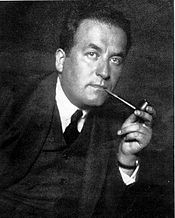 Shmuel Yosef Agnon was one of the central figures of modern Hebrew fiction, he won the 1966 Nobel prize in literature
Shmuel Yosef Agnon was one of the central figures of modern Hebrew fiction, he won the 1966 Nobel prize in literature
Israeli literature is primarily poetry and prose written in Hebrew, as part of the renaissance of Hebrew as a spoken language since the mid-19th century, although a small body of literature is published in other languages, such as English. By law, two copies of all printed matter published in Israel must be deposited in the Jewish National and University Library at the Hebrew University of Jerusalem. In 2001, the law was amended to include audio and video recordings, and other non-print media.[347] In 2006, 85 percent of the 8,000 books transferred to the library were in Hebrew.[348]
The Hebrew Book Week (He: שבוע הספר) is held each June and features book fairs, public readings, and appearances by Israeli authors around the country. During the week, Israel's top literary award, the Sapir Prize, is presented.
In 1966, Shmuel Yosef Agnon shared the Nobel Prize in Literature with German Jewish author Nelly Sachs.[349] Leading Israeli poets have been Yehuda Amichai, Nathan Alterman and Rachel Bluwstein. Internationally famous contemporary Israeli novelists include Amos Oz and David Grossman.
Israel has also been the home of two leading Palestinian poets and writers: Emile Habibi, whose novel The Secret Life of Saeed the Pessoptimist, and other writings, won him the Israel prize for Arabic literature; and Mahmoud Darwish, considered by many to be "the Palestinian national poet."[350] Darwish was born and raised in northern Israel, but lived his adult life abroad after joining the Palestine Liberation Organization.
Music and dance
Israeli music contains musical influences from all over the world; Sephardic music, Hasidic melodies, Belly dancing music, Greek music, jazz, and pop rock are all part of the music scene.[351][352]
The nation's canonical folk songs, known as "Songs of the Land of Israel," deal with the experiences of the pioneers in building the Jewish homeland.[353]
Among Israel's world-renowned[354][355] orchestras is the Israel Philharmonic Orchestra, which has been in operation for over seventy years and today performs more than two hundred concerts each year.[356] Israel has also produced many musicians of note, some achieving international stardom. Itzhak Perlman, Pinchas Zukerman and Ofra Haza are among the internationally acclaimed musicians born in Israel.
Israel has participated in the Eurovision Song Contest nearly every year since 1973, winning the competition three times and hosting it twice.[357] Eilat has hosted its own international music festival, the Red Sea Jazz Festival, every summer since 1987.[358]
Modern dance in Israel is a flourishing field, and several Israeli choreographers such as Ohad Naharin, Rami Beer, Barak Marshall and many others, are considered to be among the most versatile and original international creators working today. Famous Israeli companies include the Batsheva Dance Company and the Kibbutz Contemporary Dance Company.
Israel is home to many Palestinian musicians, including internationally acclaimed oud and violin virtuoso Taiseer Elias, singer Amal Murkus, and brothers Samir and Wissam Joubran. Israeli Arab musicians have achieved fame beyond Israel's borders: Elias and Murkus frequently play to audiences in Europe and America, and oud player Darwish Darwish (Prof. Elias's student) was awarded first prize in the all-Arab oud contest in Egypt in 2003. The Jerusalem Academy of Music and Dance has an advanced degree program, headed by Taiseer Elias, in Arabic music.
Cinema and theatre
Nine Israeli films have been final nominees for Best Foreign Language Film at the Academy Awards since the establishment of Israel. The 2009 movie Ajami was the third consecutive nomination of an Israeli film.[359]
Continuing the strong theatrical traditions of the Yiddish theater in Eastern Europe, Israel maintains a vibrant theatre scene. Founded in 1918, Habima Theatre in Tel Aviv is Israel's oldest repertory theater company and national theater.[360]
Palestinian Israeli filmmakers have made a number of films, some of them very controversial, dealing with the Arab-Israel conflict and the status of Palestinians within Israel. Mohammed Bakri's 2002 film Jenin, Jenin, about an Israeli military action in the West Bank town of Jenin, won the Best Film award at the Carthage International film festival, but was widely criticized within Israel for distorting the story of the battle. Ajami, a 2009 film about violence and discrimination in a mixed Jewish-Arab neighborhood in south Tel Aviv-Jaffa, was written and directed jointly by Palestinain Scandar Copti and Jewish Israeli Yaron Shani. It won an honorable mention in the Cannes Film Festival. The Syrian Bride, about a Druze wedding between families on opposite sides of the Israel-Syrian ceasefire line in the Golan Heights, was directed by a Jewish Israeli (Eran Riklis), but had an almost completely Druze cast.
Museums
The Israel Museum in Jerusalem is one of Israel's most important cultural institutions[361] and houses the Dead Sea scrolls,[362] along with an extensive collection of Judaica and European art.[361]
Israel's national Holocaust museum, Yad Vashem, houses the world's largest archive of Holocaust-related information.[363]
Beth Hatefutsoth (the Diaspora Museum), on the campus of Tel Aviv University, is an interactive museum devoted to the history of Jewish communities around the world.[364]
Apart from the major museums in large cities, there are high-quality artspaces in many towns and kibbutzim. Mishkan Le'Omanut on Kibbutz Ein Harod Meuhad is the largest art museum in the north of the country.[365]
Several museums are devoted to Islamic culture, including the Rockefeller Museum, which specializes in archaeological remains from the Ottoman and other periods of Middle East history, and the Museum for Islamic Art, also in Jerusalem.
Sports
Main article: Sport in IsraelSports and physical fitness have not always been paramount in Jewish culture. Athletic prowess, which was prized by the ancient Greeks, was looked down upon as an unwelcome intrusion of Hellenistic values. This changed in the 19th century from the physical culture campaign of Max Nordau, and in the early 20th century when the Chief Rabbi of Palestine, Abraham Isaac Kook, declared that "the body serves the soul, and only a healthy body can ensure a healthy soul".[366]
The Maccabiah Games, an Olympic-style event for Jewish athletes and Israeli athletes, was inaugurated in the 1930s, and has been held every four years since then. In 1964 Israel hosted and won the Asian Nations Cup; in 1970 the Israel national football team managed to qualify to the FIFA World Cup, which is still considered the biggest achievement of Israeli football.
Israel was excluded from the 1978 Asian Games due to Arab pressure on the organizers. The exclusion left Israel in limbo and it ceased competing in Asian competitions.[367] In 1994, UEFA agreed to admit Israel and all Israeli sporting organizations now compete in Europe.
The most popular spectator sports in Israel are association football and basketball.[368] The Israeli Premier League is the country's premier soccer league, and Ligat HaAl is the premier basketball league.[369] Maccabi Haifa, Maccabi Tel Aviv, Hapoel Tel Aviv and Beitar Jerusalem are the largest sports clubs. Maccabi Tel Aviv, Maccabi Haifa and Hapoel Tel Aviv have competed in the UEFA Champions League and Hapoel Tel Aviv reached the final quarter in the UEFA Cup. Maccabi Tel Aviv B.C. has won the European championship in basketball five times.[370] Israeli tennis champion Shahar Pe'er ranked 19th in the world after competing in Dubai.[371]
Israeli grandmaster Boris Gelfand is the current Chess World Cup holder[372] and winner of the 2011 Candidates Tournament. He will play against the World Champion in the World Chess Championship 2012. The Israeli chess team won the silver medal at the 2008 Chess Olympiad[373] and the bronze at the 2010 Olympiad.
Beersheba has become a national chess center; thanks to Soviet immigration, it is home to the largest number of chess grandmasters of any city in the world.[374] The city hosted the World Team Chess Championship in 2005, and chess is taught in the city's kindergartens.[375]
To date, Israel has won seven Olympic medals since its first win in 1992, including a gold medal in windsurfing at the 2004 Summer Olympics.[376] Israel has won over 100 gold medals in the Paralympic Games and is ranked about 15th in the all-time medal count. The 1968 Summer Paralympics were hosted by Israel.[377]
Cuisine
Israeli cuisine comprises local dishes and dishes brought to the country by Jewish immigrants from around the world. Since the establishment of the State in 1948, and particularly since the late 1970s, an Israeli fusion cuisine has developed.
Israeli cuisine has adopted, and continues to adapt, elements of various styles of the Jewish cuisine, particularly the Mizrahi, Sephardic, and Ashkenazi styles of cooking, along with Moroccan Jewish, Iraqi Jewish, Ethiopian Jewish, Indian Jewish, Iranian Jewish and Yemeni Jewish influences. It incorporates many foods traditionally eaten in the Arab, Middle Eastern and Mediterranean cuisines, as falafel, hummus, shakshouka, couscous, and za'atar have become essential dishes in Israel.
See also
Notes
a. ^ The Jerusalem Law states that "Jerusalem, complete and united, is the capital of Israel" and the city serves as the seat of the government, home to the President's residence, government offices, supreme court, and parliament. United Nations Security Council Resolution 478 (20 Aug. 1980; 14–0, U.S. abstaining) declared the Jerusalem Law "null and void" and called on member states to withdraw their diplomatic missions from Jerusalem. The United Nations and all member nations refuse to accept the Jerusalem Law (see Kellerman 1993, p. 140) and maintain their embassies in other cities such as Tel Aviv, Ramat Gan, and Herzliya (see the CIA Factbook and Map of Israel). The U.S. Congress subsequently adopted the Jerusalem Embassy Act, which said that the U.S. embassy should be relocated to Jerusalem and that it should be recognized as the capital of Israel. However, the US Justice Department Office of Legal Counsel concluded that the provisions of the act "invade exclusive presidential authorities in the field of foreign affairs and are unconstitutional". Since passage of the act, all Presidents serving in office have determined that moving forward with the relocation would be detrimental to U.S. national security concerns and opted to issue waivers suspending any action on this front. The Palestinian Authority sees East Jerusalem as the capital of a future Palestinian state. The city's final status awaits future negotiations between Israel and the Palestinian Authority (see "Negotiating Jerusalem", University of Maryland). See Positions on Jerusalem for more information. References
- ^ a b c d e f g h i j k "Israel", The World Factbook (Central Intelligence Agency), 19 June 2007, https://www.cia.gov/library/publications/the-world-factbook/geos/is.html, retrieved 20 July 2007
- ^ a b "Erev Rosh Hashana: 7,797,400 Israelis". Ynet!. 26 September 2011. http://www.ynet.co.il/articles/0,7340,L-4127527,00.html. Retrieved 26 September 2011.
- ^ Press release – First data from the 2008 Population Census – Completed in July, 2009, Israeli Central Bureau of Statistics (CBS), 30 September 2009, http://www.cbs.gov.il/hodaot2009n/14_09_192e.pdf, retrieved 18 May 2010
- ^ a b c d International Monetary Fund, World Economic Outlook Database, September 2011: Report for Selected Countries and Subjects. Data for the year 2011.
- ^ a b "Human development indices". United Nations Development Programme. http://hdr.undp.org/en/media/HDR_2010_EN_Table1.pdf. Retrieved 4 November 2010.
- ^ "Israel", CIA Factbook (CIA), https://www.cia.gov/library/publications/the-world-factbook/geos/is.html, retrieved 13 April 2010
- ^ Skolnik 2007, pp. 132–232
- ^ "Israel", Country Report (Freedom House), 2007, http://www.freedomhouse.org/template.cfm?page=363&year=2007&country=7199, retrieved 15 July 2007
- ^ Then known as the Zionist Organization
- ^ Brenner, Michael; Frisch, Shelley (April 2003). Zionism: A Brief History. Markus Wiener Publishers. p. 184.
- ^ "Zionist Leaders: David Ben-Gurion 1886–1973". Israel Ministry of Foreign Affairs. http://www.mfa.gov.il/MFA/History/Modern+History/Centenary+of+Zionism/Zionist+Leaders-+David+Ben-Gurion.htm. Retrieved 13 July 2011.
- ^ a b Gilbert, Martín (2005), The Routledge Atlas of the Arab–Israeli conflict, Routledge, ISBN 978-0415359009
- ^ "The status of Jerusalem". The Question of Palestine & the United Nations. United Nations Department of Public Information. http://www.un.org/Depts/dpi/palestine/ch12.pdf. "East Jerusalem has been considered, by both the General Assembly and the Security Council, as part of the occupied Palestinian territory."
- ^ BBC News (29 March 2006). "Analysis: Kadima's big plans". http://news.bbc.co.uk/1/hi/world/middle_east/4856762.stm. Retrieved 10 October 2010.
- ^ BC Kessner, HS Today. "Israel's Hard-Learned Lessons". http://www.hstoday.us/content/view/891/92/. Retrieved 7 October 2010.[dead link]
- ^ The Institute for National Security Studies. "The Legacy of Undefined Borders, Tel Aviv Notes No. 40, June 5, 2002". http://www.inss.org.il/publications.php?cat=21&incat=&read=203. Retrieved 7 October 2010.
- ^ The Epoch Times. "Israel Journal: A Land Without Borders". http://www.theepochtimes.com/n2/content/view/34590/. Retrieved 7 October 2010.
- ^ a b c d "Population". http://www.cbs.gov.il/www/yarhon/b1_e.htm.
- ^ a b "Israel closes decade with population of 7.5 million", Haaretz, 31 December 2009, http://www.haaretz.com/hasen/spages/1138784.html, retrieved 31 December 2009
- ^ a b Time Series-DataBank, Central Bureau of Statistics, http://www.cbs.gov.il/ts/, retrieved 20 February 2009
- ^ "Selected Statistics on Jerusalem Day 2007 (Hebrew)". Israel Central Bureau of Statistics. 14 May 2007. http://www.cbs.gov.il/hodaot2007n/11_07_084b.doc.
- ^ Golan belongs to Syria, Druze protest
- ^ Rummel 1997, p. 257. "A current list of liberal democracies includes: Andorra, Argentina, ... , Cyprus, ... , Israel, ..."
- ^ Global Survey 2006: Middle East Progress Amid Global Gains in Freedom, Freedom House, 19 December 2005, http://www.freedomhouse.org/template.cfm?page=70&release=317, retrieved 1 July 2007
- ^ WHO: Life expectancy in Israel among highest in the world Haaretz, May, 2009.
- ^ International Monetary Fund, World Economic Outlook Database, April 2011: Nominal GDP list of countries. Data for the year 2010.
- ^ a b "Israel's accession to the OECD". Oecd.org. http://www.oecd.org/document/38/0,3343,en_2649_34487_45697574_1_1_1_1,00.html. Retrieved 29 September 2010.
- ^ Popular Opinion, The Palestine Post, 7 December 1947, p. 1, http://www.jpress.org.il/Repository/getFiles.asp?Style=OliveXLib:LowLevelEntityToSaveGifMSIE_TAUEN&Type=text/html&Locale=english-skin-custom&Path=PLS/1947/12/07&ChunkNum=-1&ID=Ar00105&PageLabel=1[dead link]
- ^ "On the Move", Time, 31 May 1948, http://www.time.com/time/magazine/article/0,9171,798687-2,00.html, retrieved 6 August 2007
- ^ Levine, Robert A. (7 November 2000), "See Israel as a Jewish Nation-State, More or Less Democratic", The New York Times, ISSN 0294-8052, http://www.nytimes.com/2000/11/07/opinion/07iht-edlevine.t.html, retrieved 19 January 2011
- ^ Wells, John C. (1990), Longman pronunciation dictionary, Harlow, England: Longman, p. 381, ISBN 0582053838 entry "Jacob".
- ^ "And he said, Thy name shall be called no more Jacob, but Israel: for as a prince hast thou power with God and with men, and hast prevailed." (Genesis, 32:28, 35:10). See also Hosea 12:5.
- ^ Exodus 6:16–20
- ^ Barton & Bowden 2004, p. 126. "The Merneptah Stele... is arguably the oldest evidence outside the Bible for the existence of Israel as early as the 13th century BCE."
- ^ Judaism in late antiquity, Jacob Neusner, Bertold Spuler, Hady R Idris, BRILL, 2001, p. 155
- ^ Art and Judaism in the Greco-Roman world: toward a new Jewish archaeology, Steven Fine, Cambridge University Press, 2005, pp. 13–14
- ^ From the King James Version of the Bible: "And the Lord thy God will bring thee into the land which thy fathers possessed, and thou shalt possess it; and he will do thee good, and multiply thee above thy fathers." (Deuteronomy, 30:5).
- ^ From the King James Version of the Bible: "But if ye turn unto me, and keep my commandments, and do them; though there were of you cast out unto the uttermost part of the heaven, yet will I gather them from thence, and will bring them unto the place that I have chosen to set my name there." (Nehemiah, 1:9).
- ^ "Walking the Bible Timeline", Walking the Bible (Public Broadcast Television), http://www.pbs.org/walkingthebible/timeline.html, retrieved 29 September 2007
- ^ Friedland & Hecht 2000, p. 8. "For a thousand years Jerusalem was the seat of Jewish sovereignty, the household site of kings, the location of its legislative councils and courts."
- ^ Ben-Sasson 1985
- ^ Matthews, Victor H. (2002), A Brief History of Ancient Israel, Westminster John Knox Press, p. 192, ISBN 978-0664224363
- ^ Miller, J. Maxwell; Hayes, John Haralson (1986), A History of Ancient Israel and Judah, Westminster John Knox Press, p. 523, ISBN 978-0664212629
- ^ Ben-Sasson 1985, p. 1232
- ^ Scheindlin, Raymond P. (2000), A Short History of the Jewish People: From Legendary Times to Modern Statehood, Oxford University Press, p. 288, ISBN 978-0195139419
- ^ Oppenheimer, A'haron and Oppenheimer, Nili. Between Rome and Babylon: Studies in Jewish Leadership and Society. Mohr Siebeck, 2005, p. 2.
- ^ Cohn-Sherbok, Dan (1996), Atlas of Jewish History, Routledge, p. 58, ISBN 978-0415088008
- ^ "Palestine: History", The Online Encyclopedia of the Roman Provinces (The University of South Dakota), 22 February 2007, http://www.usd.edu/~clehmann/erp/Palestine/palestin.htm, retrieved 13 March 2009
- ^ Morçöl 2006, p. 304
- ^ a b c d Gil, Moshe (1997), A History of Palestine, 634–1099, Cambridge University Press, ISBN 978-0521599849
- ^ a b Kramer, Gudrun (2008), A History of Palestine: From the Ottoman Conquest to the Founding of the State of Israel, Princeton University Press, p. 376, ISBN 978-0691118970
- ^ Rosenzweig, p. 1 "Zionism, the urge of the Jewish people to return to Palestine, is almost as ancient as the Jewish diaspora itself. Some Talmudic statements ... Almost a millennium later, the poet and philosopher Yehuda Halevi ... In the 19th century ..."
- ^ a b Geoffrey Wigoder, G.G. (ed.), "Return to Zion", The New Encyclopedia of Judaism (via Answers.Com) (The Jerusalem Publishing House), http://www.answers.com/topic/return-to-zion, retrieved 8 March 2010
- ^ An invention called 'the Jewish people' – Haaretz – Israel News, Ha'aretz, archived from the original on 1 August 2008, http://web.archive.org/web/20080801082209/http://www.haaretz.com/hasen/spages/959229.html, retrieved 9 March 2010
- ^ From the King James Version of the Bible: "the Lord your God will bring you back from captivity ... and gather you again from all the peoples ... and will bring you into the land which your fathers possessed and you shall possess it" (Deut. 30:1–5).
- ^ Gilbert 2005, p. 2. "Jews sought a new homeland here after their expulsions from Spain (1492)..."
- ^ Eisen, Yosef (2004), Miraculous journey: a complete history of the Jewish people from creation to the present, Targum Press, p. 700, ISBN 1-56871-323-1
- ^ Morgenstern, Arie (2006), Hastening redemption: Messianism and the resettlement of the land of Israel, USA: Oxford University Press, p. 304, ISBN 978-0195305784
- ^ Jewish and Non-Jewish Population of Palestine-Israel (1517–2004), Jewish Virtual Library, http://www.jewishvirtuallibrary.org/jsource/Society_&_Culture/israel_palestine_pop.html, retrieved 29 March 2010
- ^ Barnai, Jacob (1992), The Jews in Palestine in the Eighteenth Century: Under the Patronage of the Istanbul committee of Officials for Palestine, University Alabama Press, p. 320, ISBN 978-0817305727
- ^ a b c d Immigration, The American-Israeli Cooperative Enterprise, http://www.jewishvirtuallibrary.org/jsource/Immigration/immigtoc.html, retrieved 12 July 2007 The source provides information on the First, Second, Third, Fourth and Fifth Aliyot in their respective articles. The White Paper leading to Aliyah Bet is discussed Jewishvirtuallibrary.org
- ^ Kornberg 1993 "How did Theodor Herzl, an assimilated German nationalist in the 1880s, suddenly in the 1890s become the founder of Zionism?"
- ^ Herzl 1946, p. 11
- ^ Chapter One: The Heralders of Zionism, Jewish Agency for Israel, http://www.jewishagency.org/JewishAgency/English/Jewish+Education/Compelling+Content/Eye+on+Israel/120/Chapter+One+The+Heralders+of+Zionism.htm, retrieved 12 July 2007
- ^ Stein 2003, p. 88. "As with the First Aliyah, most Second Aliyah migrants were non-Zionist orthodox Jews..."
- ^ Romano 2003, p. 30
- ^ Macintyre, Donald (26 May 2005), "The birth of modern Israel: A scrap of paper that changed history", The Independent (London), http://www.independent.co.uk/news/world/middle-east/the-birth-of-modern-israel-a-scrap-of-paper-that-changed-history-492084.html, retrieved 7 January 2009
- ^ Yapp, M.E. (1987). The Making of the Modern Near East 1792–1923. Harlow, England: Longman. p. 290. ISBN 0-582-49380-3.
- ^ Scharfstein 1996, p. 269. "During the First and Second Aliyot, there were many Arab attacks against Jewish settlements... In 1920, Hashomer was disbanded and Haganah ("The Defense") was established."
- ^ "League of Nations: The Mandate for Palestine, July 24, 1922", Modern History Sourcebook (Fordham University), 24 July 1922, http://www.fordham.edu/halsall/mod/1922mandate.html, retrieved 27 August 2007
- ^ J. V. W. Shaw , "A Survey of Palestine, Vol 1: Prepared in December 1945 and January 1946 for the Information of the Anglo-American Committee of Inquiry", Reprinted 1991 by The Institute for Palestine Studies, Washington, D.C., page 148
- ^ The Population of Palestine Prior to 1948, MidEastWeb, archived from the original on 27 June 2007, http://web.archive.org/web/20070627173238/http://www.mideastweb.org/palpop.htm, retrieved 12 July 2007
- ^ Fraser 2004, p. 27
- ^ Background Paper No. 47 (ST/DPI/SER.A/47), United Nations, 20 April 1949, http://unispal.un.org/UNISPAL.NSF/0/2248AF9A92B498718525694B007239C6, retrieved 31 July 2007.
- ^ Best 2003, pp. 118–119
- ^ History: Foreign Domination, Israel Ministry of Foreign Affairs, 1 October 2006, http://www.mfa.gov.il/MFA/Facts+About+Israel/History/HISTORY-+Foreign+Domination.htm, retrieved 6 July 2007
- ^ Bregman 2002, pp. 40–41
- ^ Gelber, Yoav (2006), Palestine 1948, Brighton: Sussex Academic Press, p. 17, ISBN 978-1902210674
- ^ Tal, David (2003), War in Palestine, 1948: Israeli and Arab Strategy and Diplomacy, Routledge, p. 471, ISBN 978-0714652757
- ^ Morris, Benny (2008), 1948: A History of the First Arab-Israeli War, New Haven, Conn.: Yale University Press, ISBN 0300151128
- ^ Clifford, Clark, "Counsel to the President: A Memoir", 1991, P 20.
- ^ Karsh, Efraim (2002), The Arab–Israeli conflict: The Palestine War 1948, Osprey Publishing, p. 50, ISBN 978-1841763729
- ^ Ben-Sasson 1985, p. 1058
- ^ Rabinovich, Itamar; Reinharz, Jehuda (2007), Israel in the Middle East: Documents and Readings on Society, Politics, and Foreign Relations, Pre-1948 to the Present, Brandeis, p. 74, ISBN 978-0874519624
- ^ Karsh, Efraim (2002), The Arab–Israeli conflict: The Palestine War 1948, Osprey Publishing, ISBN 978-1841763729
- ^ Morris, Benny, The Birth of the Palestinian Refugee Problem Revisited, Cambridge University Press, p. 602, ISBN 9780521009676
- ^ Two Hundred and Seventh Plenary Meeting, The United Nations, 11 May 1949, http://domino.un.org/UNISPAL.NSF/1ce874ab1832a53e852570bb006dfaf6/0b3ab8d2a7c0273d8525694b00726d1b, retrieved 13 July 2007.
- ^ Lustick 1988, pp. 37–39
- ^ "Israel (Labor Zionism)", Country Studies (Library of Congress), http://lcweb2.loc.gov/frd/cs/iltoc.html, retrieved 12 February 2010
- ^ Shulewitz, Malka Hillel (2001), The Forgotten Millions: The Modern Jewish Exodus from Arab Lands, Continuum, ISBN 978-0826447647
- ^ Population, by Religion and Population Group, Israel Central Bureau of Statistics, 2006, http://www1.cbs.gov.il/reader/shnaton/templ_shnaton_e.html?num_tab=st02_01&CYear=2006, retrieved 7 August 2007
- ^ Bard, Mitchell (2003). The Founding of the State of Israel. Greenhaven Press. p. 15.
- ^ Hakohen, Devorah (2003), Immigrants in Turmoil: Mass Immigration to Israel and Its Repercussions in the 1950s and After, Syracuse University Press, ISBN 978-0815629696; for ma'abarot population, see p. 269.
- ^ Shindler 2002, pp. 49–50
- ^ Gilbert 2005, p. 58
- ^ The Suez Crisis, University of San Diego, 5 December 2005, http://history.sandiego.edu/GEN/20th/suez.html, retrieved 15 July 2007[dead link]
- ^ Gorst, Anthony; Johnman, Lewis (1997), The Suez Crisis, Routledge, ISBN 978-0415114493
- ^ Adolf Eichmann, Jewish Virtual Library, http://www.jewishvirtuallibrary.org/jsource/Holocaust/eichmann.html, retrieved 18 September 2007
- ^ Cole 2003, p. 27. "...the Eichmann trial, which did so much to raise public awareness of the Holocaust..."
- ^ Justice Ministry Reply to Amnesty International Report, Israel Ministry of Foreign Affairs, 5 July 1995, http://www.mfa.gov.il/MFA/Government/Law/Legal%20Issues%20and%20Rulings/JUSTICE%20MINISTRY%20REPLY%20TO%201995%20AMNESTY%20INTERNATION, retrieved 10 August 2007
- ^ Maoz, Moshe (1995), Syria and Israel: From War to Peacemaking, USA: Oxford University Press, p. 70, ISBN 978-0198280187
- ^ Segev 2007, p. 178
- ^ Segev 2007, p. 289
- ^ Smith 2006, p. 126. "Nasser, the Egyptian president, decided to mass troops in the Sinai...casus belli by Israel."
- ^ Bennet, James (13 March 2005), "The Interregnum", The New York Times Magazine, http://www.nytimes.com/2005/03/13/magazine/13PALESTINIANS.html?pagewanted=2, retrieved 11 February 2010
- ^ Israel Ministry of Foreign Affairs – The Palestinian National Covenant- July 1968, Mfa.gov.il, http://www.mfa.gov.il/MFA/Foreign+Relations/Israels+Foreign+Relations+since+1947/1947-1974/33+The+Palestinian+National+Covenant-+July+1968.htm, retrieved 13 March 2009
- ^ Silke, Andrew (2004), Research on terrorism: trends, achievements & failures, Routledge, p. 149, ISBN 978-0714653112, http://books.google.com/?id=rSpfNJQ4CbAC&pg=PA149&dq=palestinian+terror+1970s&cd=1#v=onepage&q=, retrieved 8 March 2010
- ^ Gilbert, Martin (2002), The Routledge Atlas of the Arab–Israeli conflict: The Complete History of the Struggle and the Efforts to Resolve It, Routledge, p. 82, ISBN 978-0415281164, http://books.google.com/?id=UNvJ1FOwiAwC&pg=PA82&dq=palestinian+terror+1970s&cd=4#v=onepage&q=, retrieved 8 March 2010
- ^ Andrews, Edmund L. and John Kifner."George Habash, Palestinian Terrorism Tactician, Dies at 82." The New York Times. 27 Jan 2008. Retrieved 12 May 2008.
- ^ "1973: Arab states attack Israeli forces", On This Day (The BBC), 6 October 1973, http://news.bbc.co.uk/onthisday/hi/dates/stories/october/6/newsid_2514000/2514317.stm, retrieved 15 July 2007
- ^ Agranat Commission, Knesset, 2008, http://www.knesset.gov.il/lexicon/eng/agranat_eng.htm, retrieved 8 April 2010
- ^ Bregman 2002, pp. 169–170 "In hindsight we can say that 1977 was a turning point..."
- ^ Bregman 2002, pp. 171–174
- ^ Bregman 2002, pp. 186–187
- ^ Bregman 2002, pp. 186
- ^ Cleveland, William L. (1999), A history of the modern Middle East, Westview Press, p. 356, ISBN 978-0813334899
- ^ Ian Lustick (January 1997), "Has Israel Annexed East Jerusalem?", Middle East Policy V (1), archived from the original on 1 August 2008, http://web.archive.org/web/20080801164123/http://www.mepc.org/journal_vol5/9701_lustick.asp, retrieved 8 July 2007.
- ^ See for example UN General Assembly resolution 63/30, 2009 Jan 23, passed 163 for, 6 against [1]
- ^ Bregman 2002, p. 199
- ^ Tessler, Mark A. (1994), A History of the Israeli–Palestinian conflict, Indiana University Press, p. 677, ISBN 978-0253208736
- ^ Stone & Zenner 1994, p. 246. "Toward the end of 1991,... were the result of internal Palestinian terror."
- ^ Haberman, Clyde (9 December 1991), "After 4 Years, Intifada Still Smolders", The New York Times, http://query.nytimes.com/gst/fullpage.html?res=9D0CE7DB173EF93AA35751C1A967958260, retrieved 28 March 2008
- ^ Mowlana, Gerbner & Schiller 1992, p. 111
- ^ Bregman 2002, p. 236
- ^ From the End of the Cold War to 2001, Boston College, archived from the original on 14 September 2007, http://web.archive.org/web/20070914065512/http://www.bc.edu/research/cjl/meta-elements/texts/cjrelations/resources/education/Israel_Palestine/cold_war_ends.htm, retrieved 16 July 2007
- ^ The Oslo Accords, 1993, U.S. Department of State, http://history.state.gov/milestones/1990-2000/Oslo, retrieved 30 March 2010
- ^ Israel-PLO Recognition – Exchange of Letters between PM Rabin and Chairman Arafat – Sept 9- 1993, Israeli Ministry of Foreign Affairs, http://www.mfa.gov.il/MFA/Peace%20Process/Guide%20to%20the%20Peace%20Process/Israel-PLO%20Recognition%20-%20Exchange%20of%20Letters%20betwe, retrieved 31 March 2010
- ^ Harkavy & Neuman 2001, p. 270. "Even though Jordan in 1994 became the second country, after Egypt to sign a peace treaty with Israel..."
- ^ Settlements information, Foundation for Middle East Peace, Sources of Population Growth: Total Israeli Population and Settler Population, 1991–2003, archived from the original on 11 May 2008, http://web.archive.org/web/20080511203844/http://www.fmep.org/settlement_info/stats_data/settler_population_growth/sources_population_growth_1991-2003.html, retrieved 12 December 2007
- ^ Kurtzer, Daniel; Lasensky,Scott (2008), Negotiating Arab-Israeli peace: American leadership in the Middle East, United States Institute of Peace Press, p. 44, ISBN 978-1601270306
- ^ Cleveland, William L. (1999), A history of the modern Middle East, Westview Press, p. 494, ISBN 978-0813334899
- ^ "Israel marks Rabin assassination". BBC News. 12 November 2005. http://news.bbc.co.uk/2/hi/middle_east/4431728.stm.
- ^ Bregman 2002, p. 257
- ^ The Wye River Memorandum, U.S. Department of State, 23 October 1998, http://www.state.gov/www/regions/nea/981023_interim_agmt.html, retrieved 30 March 2010
- ^ Gelvin 2005, p. 240
- ^ "West Bank barrier route disputed, Israeli missile kills 2". The Associated Press (via USA Today). 29 July 2004. http://www.usatoday.com/news/world/2004%20Jul%2029-west-bank_x.htm. Retrieved 16 July 2007.[dead link]
- ^ "Permanent Ceasefire to Be Based on Creation Of Buffer Zone Free of Armed Personnel Other than UN, Lebanese Forces" United Nations Security Council, 11 August 2006
Escalation of hostilities in Lebanon and in Israel since Hizbollah's attack on Israel on 12 July 2006 - ^ Harel, Amos (13 July 2006), "Hezbollah kills 8 soldiers, kidnaps two in offensive on northern border", Haaretz, http://www.haaretz.com/hasen/pages/ShArt.jhtml?itemNo=737825, retrieved 13 August 2006
- ^ Walker, Peter; News Agencies (21 May 2008), "Olmert confirms peace talks with Syria", The Guardian (London), http://www.guardian.co.uk/world/2008/may/21/israelandthepalestinians.syria, retrieved 21 May 2008, "Israel and Syria are holding indirect peace talks, with Turkey acting as a mediator..."
- ^ Koutsoukis, Jason (5 January 2009), "Battleground Gaza: Israeli ground forces invade the strip", Sydney Morning Herald, http://www.smh.com.au/news/world/battleground-gaza/2009/01/04/1231003847085.html, retrieved 5 January 2009
- ^ Ravid, Barak (19 January 2009), "IDF begins Gaza troop withdrawal, hours after ending 3-week offensive", Haaretz, http://www.haaretz.com/hasen/spages/1056246.html, retrieved 29 January 2009
- ^ Azoulay, Yuval (1 February 2009), Two IDF soldiers, civilian lightly hurt as Gaza mortars hit Negev, Haaretz, http://haaretz.com/hasen/spages/1060562.html, retrieved 12 April 2009
- ^ "Area of Districts, Sub-Districts, Natural Regions and Lakes" (PDF), Statistical Abstract of Israel (Israel Central Bureau of Statistics), 2006, http://www1.cbs.gov.il/shnaton57/st01_01.pdf
- ^ "Israel (Geography)", Country Studies (The Library of Congress), 7 May 2009, http://lcweb2.loc.gov/frd/cs/iltoc.html, retrieved 12 February 2010
- ^ The Living Dead Sea, Israel Ministry of Foreign Affairs, 1 April 1999, ISBN 0826404065, http://www.mfa.gov.il/MFA/MFAArchive/1990_1999/1999/4/FOCUS%20on%20Israel-%20The%20Living%20Dead%20Sea, retrieved 20 July 2007
- ^ Makhteshim Country, UNESCO, ISBN 9546421359, http://whc.unesco.org/en/tentativelists/1486/, retrieved 19 September 2007
- ^ Jacobs 1998, p. 284. "The extraordinary Makhtesh Ramon – the largest natural crater in the world..."
- ^ Makhtesh Ramon, Jewish Virtual Library, http://www.jewishvirtuallibrary.org/jsource/vie/Ramon.html, retrieved 12 February 2010
- ^ Rinat, Zafrir (2 June 2008), "More endangered than rain forests?", Haaretz, http://www.haaretz.com/hasen/spages/988204.html, retrieved 29 July 2008
- ^ Goldreich 2003, p. 85
- ^ Watzman, Haim (8 February 1997), Left for dead, http://environment.newscientist.com/article/mg15320684.400-left-for-dead--plans-to-rescue-the-rapidly-shrinking-dead-sea-may-be-good-news-forindustry-and-tourists-but-the-strange-life-forms-that-thrive-in-its-supersaltywaters-still-face-a-perilous-future-says-ithaim-watzmanit.html, retrieved 29 July 2008
- ^ Average Weather for Tel Aviv-Yafo, The Weather Channel, http://www.weather.com/outlook/travel/businesstraveler/wxclimatology/monthly/graph/ISXX0026, retrieved 11 July 2007
- ^ Average Weather for Jerusalem, The Weather Channel, http://www.weather.com/outlook/events/weddings/wxclimatology/monthly/graph/ISXX0010, retrieved 11 July 2007
- ^ Sitton, Dov (20 September 2003), Development of Limited Water Resources- Historical and Technological Aspects, Israeli Ministry of Foreign Affairs, http://www.mfa.gov.il/mfa/facts%20about%20israel/land/focus%20on%20israel-%20development%20of%20limited%20water%20reso, retrieved 7 November 2007
- ^ Grossman, Gershon; Ayalon, Ofira; Baron, Yifaat; Kaufman, Debby, Solar energy for the production of heat, Samuel Neaman Institute, http://www.neaman.org.il/neaman/publications/publication_item.asp?fid=590&parent_fid=490&iid=3639, retrieved 7 November 2007
- ^ "Flora of Israel Online". Flora.huji.ac.il. http://flora.huji.ac.il/browse.asp?action=browse&group=1070. Retrieved 29 September 2010.
- ^ "The Israel Nature and Parks Authority-רשות הטבע והגנים". Parks.org.il. 28 April 2009. http://www.parks.org.il/BuildaGate5/general2/data_card.php?Cat=~~~660964978~Card13~&ru=&SiteName=parks&Clt=&Bur=351331723. Retrieved 29 September 2010.
- ^ a b "Field Listing — Executive Branch", The World Factbook (Central Intelligence Agency), 19 June 2007, https://www.cia.gov/library/publications/the-world-factbook/fields/2077.html, retrieved 20 July 2007
- ^ In 1996, direct elections for prime minister were inaugurated, but the system was declared unsatisfactory and the old one reinstated. See Israel's election process explained, BBC News, 23 January 2003, http://news.bbc.co.uk/2/hi/middle_east/2683259.stm, retrieved 31 March 2010
- ^ The Electoral System in Israel, The Knesset, http://www.knesset.gov.il/description/eng/eng_mimshal_beh.htm, retrieved 8 August 2007
- ^ Mazie 2006, p. 34
- ^ a b The Judiciary: The Court System, Israel Ministry of Foreign Affairs, 1 August 2005, http://www.mfa.gov.il/MFA/Government/Branches%20of%20Government/Judicial/The%20Judiciary-%20The%20Court%20System, retrieved 5 August 2007
- ^ Israel’s high court unique in region, The Boston Herald, 9 September 2007, http://www.bostonherald.com/news/opinion/editorial/view.bg?articleid=1030205, retrieved 15 September 2007
- ^ Israel and the International Criminal Court, Office of the Legal Adviser to the Israeli Ministry of Foreign Affairs, 30 June 2002, http://www.mfa.gov.il/MFA/MFAArchive/2000_2009/2002/6/Israel%20and%20the%20International%20Criminal%20Court, retrieved 20 July 2007
- ^ The State — Judiciary — The Court System, Israel Ministry of Foreign Affairs, 1 October 2006, http://www.mfa.gov.il/MFA/Facts+About+Israel/State/THE+STATE-+Judiciary-+The+Court+System.htm, retrieved 9 August 2007
- ^ Freedom in the World 2008 – Israel, Freedom House, 2008, http://www.freedomhouse.org/template.cfm?page=22&year=2008&country=7416, retrieved 27 May 2009
- ^ Freedom in the World 2008 – Palestinian Authority-Administered Territories (Israel), Freedom House, 2008, http://www.freedomhouse.org/template.cfm?page=363&year=2008&country=7535, retrieved 27 May 2009
- ^ Press Freedom Index 2010, Reporters Without Borders, 13 September 2011, http://en.rsf.org/press-freedom-index-2010,1034.html, retrieved 13 September 2011
- ^ (doc) Introduction to the Tables: Geophysical Characteristics, Central Bureau of Statistics, http://www.cbs.gov.il/shnaton53/download/st_eng01.doc, retrieved 4 September 2007
- ^ "More than 300.000 settlers live in west bank". http://www.haaretz.com/print-edition/news/idf-more-than-300-000-settlers-live-in-west-bank-1.280778.
- ^ "CIA world factbook".
- ^ (PDF) Localities, Population, and Density, http://www.cbs.gov.il/shnaton60/st02_16.pdf, retrieved 30 January 2010
- ^ a b (PDF) Population of localities numbering above 2,000 residents and other rural population, Central Bureau of Statistics, 30 September 2009, http://www.cbs.gov.il/population/new_2010/table3.pdf, retrieved 19 February 2010
- ^ Roberts 1990, p. 60 Although East Jerusalem and the Golan Heights have been brought directly under Israeli law, by acts that amount to annexation, both of these areas continue to be viewed by the international community as occupied, and their status as regards the applicability of international rules is in most respects identical to that of the West Bank and Gaza.
- ^ Primor, Adar (24 October 2009), "Solana: EU aims to establish a Palestinian state at the earliest possible moment within the 1967 borders.", Haaretz, http://www.haaretz.com/hasen/spages/1123034.html[dead link]
- ^ United States: "an independent and viable state based on the 1967 lines, with agreed swaps", U.S. Department of State, 25 November 2009, http://www.state.gov/secretary/rm/2009a/11/132434.htm, retrieved 10 April 2010
- ^ Golan Heights: UNSC Res. 497, UN, 1981, http://daccess-dds-ny.un.org/doc/RESOLUTION/GEN/NR0/418/84/IMG/NR041884.pdf?OpenElement, retrieved 10 April 2010
- ^ East Jerusalem: UNSC Res. 478, UN, 1980, http://domino.un.org/UNISPAL.NSF/0/dde590c6ff232007852560df0065fddb?OpenDocument, retrieved 10 April 2010
- ^ Arabs will ask UN to seek razing of Israeli wall, MSNBC, 9 July 2004, http://www.msnbc.msn.com/id/5400559/, retrieved 7 July 2010
- ^ Olmert: Willing to trade land for peace, Ynetnews, 16 December 2006, http://www.ynetnews.com/articles/0,7340,L-3340641,00.html, retrieved 26 September 2007
- ^ "Syria ready to discuss land for peace", The Jerusalem Post, 12 June 2007, archived from the original on 21 November 2007, http://web.archive.org/web/20071121060510/http://www.jpost.com/servlet/Satellite?cid=1181570258086&pagename=JPost/JPArticle/ShowFull, retrieved 26 September 2007
- ^ "Egypt: Israel must accept the land-for-peace formula", The Jerusalem Post, 15 May 2007, archived from the original on 1 May 2008, http://web.archive.org/web/20080501231415/http://www.jpost.com/servlet/Satellite?pagename=JPost/JPArticle/ShowFull&cid=1173879095966, retrieved 26 September 2007
- ^ (PDF) UNRWA in Figures: Figures as of 30 June 2009, United Nations, June 2009, http://www.unrwa.org/userfiles/uif-june09.pdf, retrieved 27 September 2007
- ^ "Questions and Answers", Israel’s Security Fence (The State of Israel), 22 February 2004, http://www.securityfence.mod.gov.il/Pages/ENG/questions.htm, retrieved 17 April 2007
- ^ United Nations High Commissioner for Refugees. "[accessed 20 June 2010". Unhcr.org. http://www.unhcr.org/refworld/docid/4875de625.html. Retrieved 29 September 2010.
- ^ "Under the Guise of Security: Routing the Separation Barrier to Enable Israeli Settlement Expansion in the West Bank", Publications (B'Tselem), December 2005, http://www.btselem.org/english/Publications/summaries/200512_Under_the_Guise_of_Security.asp, retrieved 16 April 2007
- ^ Gaza humanitarian situation (22–23 January) Office for the Coordination of Humanitarian Affairs (UN), 23 January 2009
- ^ The occupied Palestinian territories: Dignity Denied International Committee of the Red Cross, 13 December 2007
- ^ Israel/Occupied Palestinian Territories (OPT): Country Summary 2006 Human Rights Watch, January 2006. p. 1
- ^ Human rights in Palestine and other occupied Arab territories: Report of the United Nations Fact Finding Mission on the Gaza Conflict United Nations Human Rights Council, 15 September 2009. p. 85
- ^ Israel and the Occupied Territories: Road to nowhere Amnesty International, 1 December 2006
- ^ a b The scope of Israeli control in the Gaza Strip, Btselem.org, http://www.btselem.org/english/Gaza_Strip/Gaza_Status.asp, retrieved 31 March 2010
- ^ Eubam-rafah.eu portal and Eubam-rafah.eu files
- ^ "The White City of Tel Aviv" (PDF). UNESCO. http://whc.unesco.org/archive/advisory_body_evaluation/1096.pdf. Retrieved 2008-03-29.
- ^ Ina Rottscheidt, Kate Bowen, Jewish refugees put their own twist on Bauhaus homes in Israel, Deutsche Welle, 1 April 2009
- ^ Israel's Diplomatic Missions Abroad: Status of Relations, Israel Ministry of Foreign Affairs, 12 July 2006, http://www.mfa.gov.il/MFA/About%20the%20Ministry/Diplomatic%20missions/Israel-s%20Diplomatic%20Missions%20Abroad, retrieved 13 March 2009
- ^ "Massive Israel protests hit universities" (Egyptian Mail, 16 March 2010) "According to most Egyptians, almost 31 years after a peace treaty was signed between Egypt and Israel, having normal ties between the two countries is still a potent accusation and Israel is largely considered to be an enemy country"
- ^ (PDF) Initial Periodic Report of the State of Israel Concerning the Implementation of the Convention of the Rights of the Child (CRC), Israel Ministry of Justice, February 2001, pp. 147 (173 using pdf numbering), http://www.justice.gov.il/NR/rdonlyres/129A5B6A-20D6-4C3B-9785-1C6B6763394A/0/CRCengfull.pdf, retrieved 9 August 2007
- ^ (Hebrew) הוראות הדין הישראלי, Israeli Ministry of Foreign Affairs, 2004, http://www.mfa.gov.il/MFAHeb/MFAArchive/2004/horaot+din+israeli0304.htm, retrieved 9 August 2007
- ^ Israel: Background and Relations with the United States Updated, Defense Technical Information Center, http://www.dtic.mil/cgi-bin/GetTRDoc?AD=ADA470003&Location=U2&doc=GetTRDoc.pdf, retrieved 19 October 2009
- ^ a b http://pdf.usaid.gov/pdf_docs/PNADR900.pdf
- ^ http://www.census.gov/compendia/statab/2011/tables/11s1296.pdf see also http://www.census.gov/compendia/statab/cats/foreign_commerce_aid/foreign_aid.html
- ^ Migdalovitz, Carol (6 July 2007) (PDF), Israel: Background and Relations with the United States, Congressional Research Service (via the U.S. Mission to Italy), p. 23, archived from the original on 25 September 2007, http://web.archive.org/web/20070925201208/http://italy.usembassy.gov/pdf/other/RL33476.pdf, retrieved 23 September 2007
- ^ Kumar, Dinesh, India and Israel: Dawn of a New Era, Jerusalem Institute for Western Defense, archived from the original on 22 September 2007, http://web.archive.org/web/20070922185121/http://www.westerndefense.org/bulletins/Dec-01.htm, retrieved 23 September 2007
- ^ Eichner, Itamar (4 March 2009), "From India with love", Ynetnews, http://www.ynet.co.il/english/articles/0,7340,L-3696887,00.html, retrieved 4 May 2010
- ^ World Snap
- ^ "India to hold wide-ranging strategic talks with US, Israel". The Times of India. 19 January 2010. http://timesofindia.indiatimes.com/india/India-to-hold-wide-ranging-strategic-talks-with-US-Israel/articleshow/5474033.cms. Retrieved 27 June 2010.
- ^ India-Israel Commercial Relations[dead link]
- ^ Koshy, Ninan. "India and Israel Eye Iran". Fpif.org. http://www.fpif.org/fpiftxt/4959. Retrieved 1 June 2010.
- ^ "India to launch Israel-backed satellite". CNN. 21 March 2009. http://edition.cnn.com/2009/WORLD/asiapcf/03/21/india.satellite/index.html?iref=mpstoryview. Retrieved 1 June 2010.
- ^ World Tourism Directory – India replaces Korea as top Asian market for Israel
- ^ "Germany and Israel", Background Papers (German Embassy, Washington, D.C.), http://www.germany.info/relaunch/info/archives/background/israel.html, retrieved 23 September 2007[dead link]
- ^ Boyes, Roger (17 March 2008), "Israel welcomes new Germany to a celebration of its 60th birthday", The Times (London), http://www.timesonline.co.uk/tol/news/world/middle_east/article3564572.ece, retrieved 13 March 2009
- ^ "Congressional Research Service: Germany’s Relations with Israel: Background and Implications for German Middle East Policy, Jan 19, 2007. (page CRS-2)" (PDF). http://www.fas.org/sgp/crs/row/RL33808.pdf. Retrieved 29 September 2010.
- ^ "UK and Israel", Background Papers (Uk Foreign and Commonwealth Office.), http://www.fco.gov.uk/servlet/Front?pagename=OpenMarket/Xcelerate/ShowPage&c=Page&cid=1007029394365&a=KCountryProfile&aid=1031532656768, retrieved 19 December 2007
- ^ Abadi 2004, pp. 37–39, 47
- ^ Abadi 2004, pp. 47–49
- ^ Abadi 2004, p. 3. "However, it was not until 1991 that the two countries established full diplomatic relations."
- ^ Abadi 2004, pp. 4–6
- ^ Colum Lynch (30 May 2010). "Turkey urges U.N. Security Council to condemn Israeli attack on aid flotilla". Washington Post. http://www.washingtonpost.com/wp-dyn/content/article/2010/05/31/AR2010053102860.html. Retrieved 23 June 2010.
- ^ a b Qatar, Mauritania cut Israel ties, Al-Jazeera English, 17 January 2009, http://english.aljazeera.net/news/middleeast/2009/01/2009116151135307776.html, retrieved 18 May 2009
- ^ Israel Navy commandos: Gaza flotilla activists tried to lynch us
- ^ AP (7 April 2010). "Israeli Officials Claim Aid Flotilla Had Ties to Al Qaeda, PM Gives Military 'Full Support'". Fox News. http://www.foxnews.com/world/2010/05/30/reports-israeli-ships-attack-aid-flotilla-dead/. Retrieved 29 September 2010.
- ^ Mark Lavie (3 June 2010). "Israel trying to limit diplomatic damage from raid". Taiwan News. http://www.taiwannews.com.tw/etn/news_content.php?id=1275811&lang=eng_news&cate_img=1037.jpg&cate_rss=General.
- ^ Anshel Pfeffer (6 June 2010). "IDF: Five Gaza flotilla activists linked to Hamas, Al-Qaida". Haaretz. http://www.haaretz.com/news/diplomacy-defense/idf-five-gaza-flotilla-activists-linked-to-hamas-al-qaida-1.294546.
- ^ "A search for allies in a hostile world", Economist, 4 February 2010, http://www.economist.com/world/middleeast-africa/displaystory.cfm?story_id=15453225, retrieved 4 May 2010
- ^ Abn, Abi (14 January 2009) (in Spanish), Bolivia rompe relaciones diplomáticas con Israel y anuncia demanda por genocidio en Gaza, YVKE Mundial Radio, http://www.radiomundial.com.ve/yvke/noticia.php?17621, retrieved 14 April 2010
- ^ "Military spending-Arming up". The Economist. June 8, 2009. http://www.economist.com/daily/chartgallery/displaystory.cfm?story_id=13808801&fsrc=rss. Retrieved June 11, 2009.
- ^ Moti Bassok (September 30, 2009). "Defense budget to grow, education spending to shrink". Haaretz.com. http://www.haaretz.com/print-edition/business/defense-budget-to-grow-education-spending-to-shrink-1.6974. Retrieved June 9, 2010.
- ^ History: 1948, Israel Defense Forces, 2007, http://dover.idf.il/IDF/English/about/History/40s/1948/default.htm, retrieved 31 July 2007
- ^ Henderson 2003, p. 97
- ^ The State: Israel Defense Forces (IDF), Israel Ministry of Foreign Affairs, 13 March 2009, http://www.mfa.gov.il/MFA/Facts+About+Israel/State/THE+STATE-+Israel+Defense+Forces+-IDF-.htm, retrieved 9 August 2007
- ^ Israel Defense Forces, GlobalSecurity.org, http://www.globalsecurity.org/military/world/israel/idf.htm, retrieved 16 September 2007
- ^ The Israel Defense Forces, Israel Ministry of Foreign Affairs, http://www.mfa.gov.il/MFA/Facts%20About%20Israel/State/The%20Israel%20Defense%20Forces, retrieved 21 October 2006
- ^ Stendel 1997, pp. 191–192
- ^ Shtrasler, Nehemia (16 May 2007), "Cool law, for wrong population", Haaretz, archived from the original on 1 October 2007, http://web.archive.org/web/20071001050353/http://www.haaretz.com/hasen/pages/ArticleContent.jhtml?itemNo=860256, retrieved 21 July 2007
- ^ Sherut Leumi (National Service), Nefesh B'Nefesh, 4 July 2007, http://www.nbn.co.il/site/kb/questions/68/Sherut+Leumi+%28National+Service%29, retrieved 31 July 2007
- ^ Wheeler, Carolynne (6 September 2007), "Stars take the shine off military service", Globe and Mail (Canada), http://www.theglobeandmail.com/servlet/story/LAC.20070906.DRAFT06/TPStory/TPInternational/Africa/, retrieved 16 September 2007
- ^ "U.S. Aid To Israel". Jewishvirtuallibrary.org. http://www.jewishvirtuallibrary.org/jsource/US-Israel/foreign_aid.html. Retrieved 29 September 2010.
- ^ Erlanger, Steven (17 August 2007), "Israel to Get $30 Billion in Military Aid From U.S.", The New York Times, http://www.nytimes.com/2007/08/17/world/middleeast/17israel.html, retrieved 23 September 2007
- ^ Katz, Yaakov (30 March 2007), "'Arrow can fully protect against Iran'", The Jerusalem Post, archived from the original on 29 May 2008, http://web.archive.org/web/20080529042937/http://www.jpost.com/servlet/Satellite?cid=1173879211495&pagename=JPost/JPArticle/ShowFull, retrieved 16 September 2007
- ^ Zorn, E. L. (8 May 2007), Israel's Quest for Satellite Intelligence, Central Intelligence Agency, https://www.cia.gov/library/center-for-the-study-of-intelligence/kent-csi/docs/v44i5a04p.htm, retrieved 16 September 2007[dead link][dead link]
- ^ Katz, Yaakov (11 June 2007), "Analysis: Eyes in the sky", The Jerusalem Post, archived from the original on 2 May 2008, http://web.archive.org/web/20080502000559/http://www.jpost.com/servlet/Satellite?cid=1181570245958&pagename=JPost/JPArticle/ShowFull, retrieved 16 September 2007
- ^ Seitz, Charmaine (30 January 2001), Israel’s Defense Budget: The Business Side of War, The Jerusalem Fund, http://www.thejerusalemfund.org/www.thejerusalemfund.org/carryover/pubs/20010130ib.html, retrieved 16 September 2007 (first appeared in Information Brief No. 64)
- ^ Mohamed ElBaradei (27 July 2004), Transcript of the Director General's Interview with Al-Ahram News, International Atomic Energy Agency, http://www.iaea.org/NewsCenter/Transcripts/2004/alahram27072004.html, retrieved 19 July 2007
- ^ Ziv, Guy, "To Disclose or Not to Disclose: The Impact of Nuclear Ambiguity on Israeli Security," Israel Studies Forum, Vol. 22, No. 2 (Winter 2007): 76–94
- ^ Israel Homeowner Glossary, Israelhomeowner.com, 3 January 2007, archived from the original on 6 April 2008, http://web.archive.org/web/20080406045307/http://www.israelhomeowner.com/Glossary.asp, retrieved 13 March 2009
- ^ "Israeli Humanitarian Relief- MASHAV – the Israel F". Mfa.gov.il. http://www.mfa.gov.il/MFA/Mashav+%E2%80%93+International+Development/Activities/Israeli+Humanitarian+Relief-+MASHAV+-+the+Israel+F.htm. Retrieved 2011-09-15.
- ^ Share this Email Twitter FacebookRankCountryScore. "Rankings & Results « Vision of Humanity". Visionofhumanity.org. http://www.visionofhumanity.org/gpi-data/#/2011/scor. Retrieved 2011-09-15.
- ^ "Current list of OECD members". Oecd.org. 1 January 1970. http://www.oecd.org/countrieslist/0,3351,en_33873108_33844430_1_1_1_1_1,00.html. Retrieved 29 September 2010.
- ^ Economy Rankings — Middle East & North Africa, The World Bank Group, http://www.doingbusiness.org/economyrankings/default.aspx?regionid=4, retrieved 13 March 2009
- ^ Global Competitiveness Report 2006-2007, World Economic Forum, 14 February 2007, ISBN 1403996369, http://www.weforum.org/en/initiatives/gcp/Global%20Competitiveness%20Report/index.htm, retrieved 15 July 2007
- ^ Bounfour, Ahmed; Edvinsson, Leif (2005), Intellectual Capital for Communities: Nations, Regions, and Cities, Butterworth-Heinemann, p. 47, ISBN 978-0750677738
- ^ NASDAQ Appoints Asaf Homossany as New Director for Israel, NASDAQ, 6 February 2005, http://www.nasdaq.com/newsroom/news/pr2005/ne_section05_019.stm, retrieved 4 August 2007
- ^ a b "'Israel's economy most durable in face of crises', Ynet 05.20.2010". Ynetnews.com. 20 June 1995. http://www.ynetnews.com/articles/0,7340,L-3891801,00.html. Retrieved 29 September 2010.
- ^ "Data Template on International Reserves and Foreign Currency Liquidity – Reporting Countries". Imf.org. 2001-01-05. http://www.imf.org/external/np/sta/ir/IRProcessWeb/colist.aspx. Retrieved 2010-07-08.
- ^ a b Israeli exports: From $6M to $80B Ynetnews Published: 05.13.11, 07:29 / Israel Business
- ^ a b c Looking to the sun, Tom Parry, Canadian Broadcasting Corporation, August 15, 2007.
- ^ a b c Israel Pushes Solar Energy Technology, Linda Gradstein, National Public Radio, October 22, 2007.
- ^ Ginsburg, Mitch (28 May 2007), A Hotter Holy Land, The Jerusalem Report, http://pqasb.pqarchiver.com/jrep/access/1271587481.html?dids=1271587481:1271587481&FMT=ABS&FMTS=ABS:FT&date=May+28%2C+2007&author=Mitch+Ginsburg&pub=The+Jerusalem+Report&edition=&startpage=13&de/, retrieved 30 August 2007
- ^ Israel keen on IT tie-ups, The Hindu Business Line, 10 January 2001, http://www.thehindubusinessline.com/businessline/2001/01/11/stories/151139ue.htm, retrieved 4 August 2007[dead link]
- ^ Israel: Punching above its weight, Economist, 14 November 2005, http://www.ebusinessforum.com/index.asp?doc_id=7798&layout=rich_story, retrieved 4 August 2007
- ^ "OECD Factbook 2010: Economic, Environmental and Social Statistics". Oecd-ilibrary.org. http://www.oecd-ilibrary.org/sites/factbook-2010-en/07/01/01/07-01-01-g1.html?contentType=&itemId=/content/chapter/factbook-2010-55-en&containerItemId=/content/serial/18147364&accessItemIds=&mimeType=text/html. Retrieved 22 March 2011.
- ^ Krawitz, Avi (27 February 2007), "Intel to expand Jerusalem R&D", The Jerusalem Post, archived from the original on 29 September 2007, http://web.archive.org/web/20070929212346/http://www.jpost.com/servlet/Satellite?cid=1171894528658&pagename=JPost/JPArticle/ShowFull, retrieved 4 August 2007
- ^ Israel R&D Center: Leadership Team, Microsoft, archived from the original on 8 July 2007, http://web.archive.org/web/20070708084346/http://www.microsoft.com/Israel/RnD/about/team.html, retrieved 4 August 2007
- ^ "Berkshire Announces Acquisition", New York Times, 6 May 2006, http://query.nytimes.com/gst/fullpage.html?res=9C02E7DB1F3FF935A35756C0A9609C8B63, retrieved 15 May 2010
- ^ "Israel's International Investment Position (IIP), June 2009". Bank of Israel. http://www.bankisrael.gov.il/press/eng/090917/090917e.htm.
- ^ "The world owes the Israeli economy $16.9 billion". I.B.I. http://www.ibi.co.il/SIP_STORAGE/FILES/4/924.pdf.[dead link]
- ^ Burstein, Nathan (14 August 2007), "Tourist visits above pre-war level", The Jerusalem Post, archived from the original on 29 September 2007, http://web.archive.org/web/20070929222428/http://www.jpost.com/servlet/Satellite?cid=1186557443251&pagename=JPost/JPArticle/ShowFull, retrieved 4 September 2007
- ^ "Pope to visit Holy Land", Haaretz, http://www.haaretz.com/hasen/spages/1069604.html, retrieved 13 March 2009
- ^ "Interesting Facts about Israel". Jewishnorthshore.org. http://www.jewishnorthshore.org/page.aspx?id=43769. Retrieved 30 October 2010.
- ^ Roads(1)(2), By Length and Area, Israeli Central Bureau of Statistics, 2008, http://www.cbs.gov.il/shnaton60/st24_12.pdf, retrieved 5 February 2010
- ^ a b 2008 – 2.4 Million motor vehicles in Israel, Israeli Central Bureau of Statistics, 29 June 2009, http://www.cbs.gov.il/reader/newhodaot/hodaa_template.html?hodaa=200927133, retrieved 5 February 2010
- ^ Bus Services on Scheduled Routes, Israeli Central Bureau of Statistics, 2009, http://www.cbs.gov.il/shnaton60/st24_04.pdf, retrieved 5 February 2010
- ^ a b Israeli Railway Services, Israeli Central Bureau of Statistics, 2009, http://www.cbs.gov.il/shnaton60/st24_05.pdf, retrieved 5 February 2010
- ^ a b c Transportation in Israel, Jewish Virtual Library, 1 November 2001, ISBN 0080434487, http://www.jewishvirtuallibrary.org/jsource/Economy/transport.html, retrieved 5 February 2010
- ^ "Official airport statistics for Ben Gurion Airport". IAA. 25 May 2009. http://www.iaa.gov.il/Rashat/en-US/Airports/BenGurion/AbouttheAirport/Statistics. Retrieved 21 June 2011.
- ^ a b (PDF) Education, Ministry of Immigrant Absorption, http://www.moia.gov.il/NR/rdonlyres/9FBC4448-CB15-4309-BA82-96DC681E7A11/0/education_en.pdf, retrieved 5 August 2007
- ^ Higher Education in Israel, Embassy of Israel in Washington, DC, http://www.israelemb.org/highered/highed.html, retrieved 10 September 2007[dead link]
- ^ About the Library, Jewish National and University Library, http://www.jnul.huji.ac.il/eng/history.html, retrieved 5 August 2007
- ^ Top 500 World Universities (1–100), Institute of Higher Education, Shanghai Jiao Tong University, 2006, http://ed.sjtu.edu.cn/rank/2006/ARWU2006_Top100.htm, retrieved 2 July 2007
- ^ Academic Ranking of World Universities – 2009, Institute of Higher Education, Shanghai Jiao Tong University, 2009, http://www.arwu.org/ARWU2009.jsp, retrieved 14 November 2009
- ^ Top 500 World Universities, Institute of Higher Education, Shanghai Jiao Tong University, 2006, http://ed.sjtu.edu.cn/rank/2006/ARWU2006TOP500list.htm, retrieved 1 August 2007
- ^ a b Prof. Ada Yonath awarded 2009 Nobel Prize in Chemistry, Israel Ministry of Foreign Affairs, 7 October 2009, http://www.mfa.gov.il/MFA/Israel+beyond+politics/Prof_Yonath_2009_Nobel_Prize_Chemistry_7-Oct-2009, retrieved 8 February 2010
- ^ Once 'ridiculed', Israel's Shechtman wins Chemistry Nobel for atomic mosaic [2]
- ^ Heylin, Michael (27 November 2006), "Globalization Of Science Rolls On", Chemical & Engineering News (American Chemical Society): pp. 26–31, http://pubs.acs.org/cen/science/84/8448sci1.html, retrieved 21 August 2007
- ^ Gordon, Evelyn (24 August 2006), "Kicking the global oil habit", The Jerusalem Post, archived from the original on 29 September 2007, http://web.archive.org/web/20070929222456/http://www.jpost.com/servlet/Satellite?cid=1154525933299&pagename=JPost/JPArticle/Printer, retrieved 4 August 2007
- ^ Giant solar plants in Negev could power Israel's future, John Lettice, The Register, 2008 Jan 25
- ^ a b At the Zenith of Solar Energy, Neal Sandler,BusinessWeek, 2008 March 26.
- ^ Del Chiaro, Bernadette; Telleen-Lawton, Timothy (PDF), Solar Water Heating (How California Can Reduce Its Dependence on Natural Gas), Environment California Research and Policy Center, http://www.environmentcalifornia.org/uploads/at/56/at563bKwmfrtJI6fKl9U_w/Solar-Water-Heating.pdf, retrieved 29 September 2007
- ^ Gershon Grossman; Ofira Ayalon (2007), Solar energy for the production of heat Summary and recommendations of the 4th assembly of the energy forum at SNI, The Samuel Neaman Institute for Advanced Research in Science and Technology, http://www.neaman.org.il/neaman/publications/publication_item.asp?fid=590&parent_fid=490&iid=3639, retrieved 12 February 2010
- ^ "Israel Special: Solar, what else?!", Sun & Wind Energy, January 2008, http://roma.mfa.gov.il/mfm/Data/156237.pdf, retrieved 15 May 2010
- ^ "Stem cell density highest in Israel", The Scientist, 21 March 2009, http://www.the-scientist.com/news/print/23240/, retrieved 14 November 2009
- ^ Academic Ranking of World Universities – 2009, Institute of Higher Education, Shanghai Jiao Tong University, 2009, archived from the original on 1 May 2008, http://web.archive.org/web/20080501183117/http://www.arwu.org/#, retrieved 14 November 2009
- ^ Top countries in space sciences, The Times Higher Education supplemmentary, 8 October 2009, http://www.timeshighereducation.co.uk/story.asp?sectioncode=26&storycode=408577&c=1, retrieved 8 October 2009
- ^ Barbara Opall-Rome (19 November 2009), Israel Readies for Ofeq-8 Launch, Defense News, http://www.defensenews.com/story.php?i=4379028&c=MID&s=AIR, retrieved 8 February 2010
- ^ Tran, Mark (21 January 2008), "Israel launches new satellite to spy on Iran", The Guardian (London), http://www.guardian.co.uk/iran/story/0,,2244324,00.html, retrieved 22 January 2008
- ^ Israel at 62: Population of 7,587,000, Ynet, 18 April 2010, http://www.ynetnews.com/articles/0,7340,L-3877574,00.html
- ^ Johnathan Marcus (2 May 2005), "Israeli Arabs: 'Unequal citizens'", BBC News, http://news.bbc.co.uk/2/hi/middle_east/4493525.stm, retrieved 6 December 2007
- ^ Israel: Crackdown on illegal migrants and visa violators. Integrated Regional Information Networks (IRIN). 14 July 2009
- ^ Adriana Kemp, "Labour migration and racialisation: labour market mechanisms and labour migration control policies in Israel", Social Identities 10:2, 267–292, 2004
- ^ "Flow of African migrants poses dilemma for Israel", The Washington Post, 15 April 2011
- ^ DellaPergola, Sergio (2000) [2000], Still Moving: Recent Jewish Migration in Comparative Perspective, Daniel J. Elazar and Morton Weinfeld eds., ed., ‘The Global Context of Migration to Israel’, New Brunswick, New Jersey: Transaction Publishers, pp. 13–60, ISBN 1-56000-428-2
- ^ Herman, Pini (1 September 1983), "The Myth of the Israeli Expatriate", Moment Magazine 8 (8): 62–63
- ^ Gould, Eric; Moav, Omer (July 2006). "Brain Drain From Israel (Brichat Mochot M'Yisrael)" (in Hebrew) (PDF). Jerusalem: Mercaz Shalem — The Shalem Center, The Social-Economic Institute. p. 26. Archived from the original on 3 August 2008. http://web.archive.org/web/20080803015957/http://www.shalem.org.il/Admin/FileServer/df4b061c96a6fbceb95026260cb4de8a.pdf. Retrieved 12 October 2010.
- ^ Rettig, Haviv (6 April 2008), "Officials to US to bring Israelis home", Jerusalem Post, archived from the original on 2 June 2008, http://web.archive.org/web/20080602204820/http://www.jpost.com/servlet/Satellite?pagename=JPost/JPArticle/ShowFull&cid=1207238165607, retrieved 29 April 2008
- ^ "Settlements in the West Bank", Settlement Information (Foundation for Middle East Peace), archived from the original on 24 February 2008, http://web.archive.org/web/20080224233451/http://www.fmep.org/settlement_info/stats_data/west_bank_settlements.html, retrieved 12 December 2007
- ^ "Settlements in the Golan Heights", Settlement Information (Foundation for Middle East Peace), http://www.fmep.org/settlement_info/settlement-info-and-tables/stats-data/settlements-in-the-golan-heights, retrieved 12 December 2007
- ^ "Settlements in East Jerusalem", Settlement Information (Foundation for Middle East Peace), archived from the original on 20 April 2008, http://web.archive.org/web/20080420070744/http://www.fmep.org/settlement_info/stats_data/east_jerusalem_settlements.html, retrieved 12 December 2007
- ^ "Settlements in the Gaza Strip", Settlement Information (Foundation for Middle East Peace), http://www.fmep.org/settlement_info/settlement-info-and-tables/stats-data/settlements-in-the-gaza-strip-1, retrieved 12 December 2007
- ^ The Law of Return, Knesset, http://www.knesset.gov.il/laws/special/eng/return.htm, retrieved 14 August 2007
- ^ Central Bureau of Statistics, Government of Israel (PDF), Jews and others, by origin, continent of birth and period of immigration, http://www1.cbs.gov.il/shnaton56/st02_24.pdf, retrieved 8 April 2006
- ^ Aharoni, Ada "The Forced Migration of Jews from Arab Countries", Historical Society of Jews from Egypt website. Retrieved 1 February 2009.
- ^ [From Sephardi to Mizrahi and Back Again: Changing Meanings of “Sephardi” in Its Social Environments http://muse.jhu.edu/journals/jss/summary/v015/15.1.goldberg.html]
- ^ "The myth of the Mizrahim", Guardian.co.uk, 3 April 2009
- ^ Jacqueline Shields. "Jewish Refugees from Arab Countries". http://www.jewishvirtuallibrary.org/jsource/History/jewref.html.
- ^ "Missing Mizrahim". http://www.jewcy.com/post/missing_mizrahim.
- ^ Israel may admit 3,000 Ethiopia migrants if Jews. Reuters. 16 July 2009
- ^ Aug 16-1816635503_x.htm Israel's Welcome for Ethiopian Jews Wears Thin[dead link]. USA Today 16 August 2008
- ^ Friedberg, Rachel M. (November 2001), "The Impact of Mass Migration on the Israeli Labor Market", The Quarterly Journal of Economics 116 (4): 1373, doi:10.1162/003355301753265606, http://www.mitpressjournals.org/doi/abs/10.1162/003355301753265606?journalCode=qjec
- ^ Study: Soviet immigrants outperform Israeli students, Haaretz, 10 February 2008
- ^ "Israel's disputatious Avigdor Lieberman: Can the coalition hold together?", The Economist, 11 March 2010
- ^ Q&A Lily Galili on 'The Russians in Israel'. Haaretz
- ^ Elazar, Daniel J., Religion in Israel: A Consensus for Jewish Tradition, Jerusalem Center for Public Affairs, http://www.jcpa.org/dje/articles2/relinisr-consensus.htm, retrieved 6 September 2007
- ^ "The other Israeli conflict: with itself", CSMonitor.com, 9 July 2009.
- ^ "At the edge of the abyss", Haaretz.com, 24 November 2009
- ^ Central Bureau of Statistics, Government of Israel (PDF), Population, by religion and population group, http://www1.cbs.gov.il/shnaton56/st02_01.pdf, retrieved 6 August 2007
- ^ Bassok, Moti (25 December 2006), "Israel's Christian population numbers 148, 000 as of Christmas Eve", Haaretz, http://www.haaretz.com/hasen/spages/805277.html, retrieved 29 July 2008
- ^ (PDF) National Population Estimates, Central Bureau of Statistics, p. 27, http://www.cbs.gov.il/shnaton53/st_eng02.pdf, retrieved 6 August 2007
- ^ Levine, Lee I. (1999), Jerusalem: its sanctity and centrality to Judaism, Christianity, and Islam, Continuum International Publishing Group, p. 516, ISBN 978-0826410245
- ^ The Bahá'í World Centre: Focal Point for a Global Community, The Bahá'í International Community, http://info.bahai.org/article-1-6-0-5.html, retrieved 2 July 2007
- ^ Teaching the Faith in Israel, Bahá'í Library Online, 23 June 1995, http://bahai-library.com/uhj_teaching_in_israel, retrieved 6 August 2007
- ^ "Comparing Education Statistics Across the World" (PDF), Global Education Digest 2004 (UNESCO Institute for Statistics): pp. 75, 77, 2004, http://www.unesco.org/education/docs/EN_GD2004_v2.pdf, retrieved 4 August 2007
- ^ "Human Development Indicators" (PDF), Human Development Report 2005 (United Nations), 2005, archived from the original on 2 July 2007, http://web.archive.org/web/20070702184520/http://hdr.undp.org/reports/global/2005/pdf/HDR05_HDI.pdf, retrieved 4 August 2007
- ^ ED250227 – Israeli Schools: Religious and Secular Problems, Eric.ed.gov, 10 October 1984, http://www.eric.ed.gov/ERICWebPortal/custom/portlets/recordDetails/detailmini.jsp?_nfpb=true&_&ERICExtSearch_SearchValue_0=ED250227&ERICExtSearch_SearchType_0=eric_accno&accno=ED250227, retrieved 13 March 2009
- ^ Kashti, Or; Shahar Ilan (19 July 2007), "Knesset raises school dropout age to 18", Haaretz, http://www.haaretz.com/hasen/spages/883341.html, retrieved 5 August 2007
- ^ Summary of the Principal Laws Related to Education, Israel Ministry of Foreign Affairs, 26 January 2003, http://www.mfa.gov.il/MFA/MFAArchive/2000_2009/2003/1/Summary+of+the+principal+laws+relating+to+educatio.htm, retrieved 4 August 2007
- ^ The Israeli Matriculation Certificate, United States-Israel Educational Foundation via the University of Szeged University Library, January 1996, http://www.bibl.u-szeged.hu/oseas/bagrut.html, retrieved 5 August 2007
- ^ (PDF) Pupils in Grade XII, matriculation examinees and entitled to a certificate, Central Bureau of Statistics, http://www1.cbs.gov.il/shnaton56/st08_21.pdf, retrieved 2 July 2007
- ^ Top Ten Reasons to Invest in Israel, Israeli Consulate, New York City, archived from the original on 16 July 2007, http://web.archive.org/web/20070716015552/http://www.israelfm.org/economic/investing/top_ten.htm, retrieved 1 August 2007
- ^ "Israel: IT Workforce", Information Technology Landscape in Nations Around the World (American University), http://www.american.edu/initeb/as5415a/Israel_ICT/itWork.html, retrieved 14 August 2007
- ^ Immigration and Social and Cultural Diversity Among the Jewish Population, International Youth Foundation, archived from the original on 10 October 2007, http://web.archive.org/web/20071010072008/http://www.iyfnet.org/document.cfm/92/97/243, retrieved 6 September 2007
- ^ Jewish Festivals and Days of Remembrance in Israel, Israel Ministry of Foreign Affairs, http://www.mfa.gov.il/MFA/Facts%20About%20Israel/People/Jewish%20Festivals%20in%20Israel, retrieved 16 September 2007
- ^ Ran, Ami (25 August 1998), Encounters: The Vernacular Paradox of Israeli Architecture, Ministry of Foreign Affairs, http://www.mfa.gov.il/MFA/MFA+Publications/Photo+exhibits/Encounters-+The+Vernacular+Paradox+of+Israeli+Arch-+Intro.htm, retrieved 6 September 2007
- ^ Brinn, David (23 October 2005), Israeli, Palestinian and Jordanian DJs create bridge for peace, Israel21c, http://www.israel21c.org/bin/en.jsp?enDispWho=Articles%5El1126&enPage=BlankPage&enDisplay=view&enDispWhat=object&enVersion=0&enZone=Culture, retrieved 16 September 2007
- ^ The International Israeli Table, Israel Ministry of Foreign Affairs, http://www.mfa.gov.il/MFA/History/Modern%20History/Israel%20at%2050/The%20International%20Israeli%20Table, retrieved 26 June 2009
- ^ Depositing Books to The Jewish National & University Library, Jewish National and University Library, http://jnul.huji.ac.il/eng/lgd.html, retrieved 21 August 2007
- ^ Israeli Book Statistics for 2006, Jewish National and University Library, http://jnul.huji.ac.il/eng/lgd-statistics-2007.html, retrieved 12 August 2007
- ^ The Nobel Prize in Literature 1966, Nobel Foundation, http://nobelprize.org/nobel_prizes/literature/laureates/1966/index.html, retrieved 12 August 2007
- ^ BBC News 9 August 2008 Palestinian 'national poet' dies
- ^ Broughton, Ellingham & Trillo 1999, pp. 365–369
- ^ "Israel", World Music (National Geographic Society), http://worldmusic.nationalgeographic.com/worldmusic/view/page.basic/country/content.country/israel_36, retrieved 13 August 2007
- ^ "Israeli Folk", World Music (National Geographic Society), http://worldmusic.nationalgeographic.com/worldmusic/view/page.basic/genre/content.genre/israeli_folk_735, retrieved 13 August 2007
- ^ Ben-Sasson 1985, p. 1095
- ^ Ewbank, Alison J.; Papageorgiou, Fouli T. (1997), Whose Master's Voice?: The Development of Popular Music in Thirteen Cultures, Greenwood Press, p. 117, ISBN 978-0313277726
- ^ Davis, Barry (5 February 2007), Israel Philharmonic Orchestra celebrates 70th anniversary, Ministry of Foreign Affairs (from Israel21c), http://www.mfa.gov.il/MFA/Israel+beyond+politics/Israel+Philharmonic+Orchestra+celebrates+70th+anniversary+5-Feb-2007.htm, retrieved 13 August 2007
- ^ "Israel", Eurovision Song Contest (Eurovision Broadcasting Union), archived from the original on 22 June 2007, http://web.archive.org/web/20070622035651/http://www.eurovision.tv/content/view/537/1, retrieved 13 August 2007
- ^ About Us, Red Sea Jazz Festival, archived from the original on 12 August 2007, http://web.archive.org/web/20070812185754/http://www.redseajazzeilat.com/EN/aboutus.html, retrieved 13 August 2007
- ^ Brown, Hannah (2 February 2010), "‘Ajami’ nominated for Oscar", Jerusalem Post, http://www.jpost.com/ArtsAndCulture/Entertainment/Article.aspx?id=167582
- ^ (Hebrew) התיאטרון הלאומי הבימה, Habima National Theatre, http://www.habima.co.il/, retrieved 13 August 2007
- ^ a b About the Museum, The Israel Museum, Jerusalem, http://www.imj.org.il/eng/about/index.html, retrieved 13 August 2007
- ^ Shrine of the Book, The Israel Museum, Jerusalem, http://www.imj.org.il/eng/shrine/index.html, retrieved 13 August 2007
- ^ About Yad Vashem: The Yad Vashem Library, Yad Vashem, archived from the original on 6 July 2007, http://web.archive.org/web/20070706175402/http://www1.yadvashem.org/about_yad/index_about_yad.html, retrieved 13 August 2007
- ^ Museum Information, Beth Hatefutsoth, http://www.bh.org.il/about-us.aspx, retrieved 13 August 2007
- ^ TravelNet in cooperation with Israel museums, Mishkan LeOmanut, Ein Harod, Ilmuseums.com, http://www.ilmuseums.com/museum_eng.asp?id=183, retrieved 13 March 2009
- ^ Griver, Simon (June 1999), Sports in Israel, Jewish Virtual Library, http://www.jewishvirtuallibrary.org/jsource/Society_&_Culture/sports.html, retrieved 13 August 2007
- ^ Montague, James (27 Feb 2008), "Time is right for Israel to return to its Asian roots", The Guardian (London), http://www.guardian.co.uk/football/2008/feb/27/worldcup2010, retrieved 4 May 2010
- ^ Torstrick 2004, p. 141
- ^ Basketball Super League Profile, Winner Basketball Super League, http://www.basket.co.il/Data.asp?id=1&lang=en, retrieved 13 August 2007
- ^ Bouskila, Daniel (13 May 2005), "Israel Wins More Than Hoop Crown", The Jewish Journal, http://www.jewishjournal.com/opinion/article/israel_wins_more_than_hoop_crown_20050513/, retrieved 21 August 2007
- ^ "Israeli tennis stars return to action", The Jerusalem Post, 26 December 2006, http://www.jpost.com/Sports/Article.aspx?id=45927, retrieved 4 May 2010
- ^ Shvidler, Eli (15 December 2009), "Israeli grand master Boris Gelfand wins Chess World Cup", Haaretz, http://www.haaretz.com/hasen/spages/1135219.html
- ^ Tzahor, Uri (26 November 2008), "Israel takes silver medal at Chess Olympiad", Ynewnews.com, http://www.ynet.co.il/english/articles/0,7340,L-3628765,00.html
- ^ Bekerman, Eitan (4 September 2006), "Chess masters set to compete in world blitz championship", Haaretz, http://www.haaretz.com/hasen/spages/758461.html[dead link]
- ^ World Team Championship in Beer Sheva, Israel, World Chess Federation, 1 November 2005, http://www.fide.com/component/content/article/9-other/2182-673-world-team-championship-in-beer-sheva-israel, retrieved 13 March 2009
- ^ Olympic Medal Winners (under Europe / Israel), International Olympic Committee, http://www.olympic.org/uk/athletes/results/search_r_uk.asp, retrieved 13 August 2007
- ^ Tel Aviv 1968, International Paralympic Committee, http://www.paralympic.org/Paralympic_Games/Past_Games/Tel_Aviv_1968/index.html, retrieved 20 September 2008
Bibliography
- Abadi, Jacob (2004), Israel's Quest for Recognition and Acceptance in Asia: Garrison State Diplomacy, Routledge, ISBN 0-7146-5576-7
- Ausubel, Natan (1964), The Book of Jewish Knowledge, New York, New York: Crown Publishers, ISBN 0-517-09746-X
- Barton, John; Bowden, Julie (2004), The Original Story: God, Israel and the World, Wm. B. Eerdmans Publishing Company, ISBN 0-8028-2900-7
- Barzilai, Gad (1996), Wars, Internal Conflicts, and Political Order: A Jewish Democracy in the Middle East, State University of New York Press, ISBN 0-7914-2943-1
- Barzilai, Gad (2010), The Attorney General and the State Prosecutor-Is Institutional Separation Warrented?, The Israel Democracy Institute
- Ben-Sasson, Hayim (1985), A History of the Jewish People, Harvard University Press, ISBN 978-0-674-39731-6
- Best, Anthony (2003), International History of the Twentieth Century, Routledge, ISBN 0-415-20739-8
- Bregman, Ahron (2002), A History of Israel, Palgrave Macmillan, ISBN 0-333-67631-9
- Broughton, Simon; Ellingham, Mark; Trillo, Richard (1999), World Music: The Rough Guide, Rough Guides, ISBN 1-85828-635-2
- Cole, Tim (2003), Holocaust City: The Making of a Jewish Ghetto, Routledge, ISBN 0-415-92968-7
- Crowdy, Terry (2006), The Enemy Within: A History of Espionage, Osprey Publishing, ISBN 1-84176-933-9
- Dekmejian, R. Hrair (1975), Patterns of Political Leadership: Egypt, Israel, Lebanon, State University of New York Press, ISBN 0-87395-291-X
- Friedland, Roger; Hecht, Richard (2000), To Rule Jerusalem, University of California Press, ISBN 0-520-22092-7
- Gelvin, James L. (2005), The Israel-Palestine Conflict: One Hundred Years of War, Cambridge University Press, ISBN 0-521-85289-7
- Gilbert, Martin (2005), The Routledge Atlas Of The Arab–Israeli conflict (8th ed.), Routledge, ISBN 0-415-35900-7
- Goldreich, Yair (2003), The Climate of Israel: Observation, Research and Application, Springer, ISBN 0-306-47445-X
- Hamilton, Victor P. (1995), The Book of Genesis (2nd revised ed.), Wm. B. Eerdmans Publishing Company, ISBN 0-8028-2309-2
- Harkavy, Robert E.; Neuman, Stephanie G. (2001), Warfare and the Third World, Palgrave Macmillan, ISBN 0-312-24012-0
- Henderson, Robert D'A. (2003), Brassey's International Intelligence Yearbook (2003 ed.), Brassey's Inc., ISBN 1-57488-550-2
- Herzl, Theodor (1946), The Jewish State, American Zionist Emergency Council, ISBN 0-486-25849-1
- Howe, Kathleen Stewart (1997), Revealing the Holy Land: the photographic exploration of Palestine, University of California Press, p. 144, ISBN 978-0-89951-095-8, http://books.google.com/?id=w0mml-378QQC&printsec=frontcover&q=
- Jacobs, Daniel (1988), Israel and the Palestinian Territories: The Rough Guide (2nd revised ed.), Rough Guides, ISBN 1-85828-248-9
- Kellerman, Aharon (1993), Society and Settlement: Jewish Land of Israel in the Twentieth Century, State University of New York Press, ISBN 0-7914-1295-4
- Kornberg, Jacques (1993), Theodor Herzl: From Assimilation to Zionism, Indiana University Press, ISBN 0-253-33203-6
- Liebreich, Fritz (2005), Britain's Naval and Political Reaction to the Illegal Immigration of Jews to Palestine, 1945–1948, Routledge, ISBN 0-7146-5637-2
- Lustick, Ian (1988), For the Land and the Lord: Jewish Fundamentalism in Israel, Council on Foreign Relations Press, ISBN 0-87609-036-6
- Mazie, Steven (2006), Israel's Higher Law: Religion and Liberal Democracy in the Jewish State, Lexington Books, ISBN 0-7391-1485-9
- Morçöl, Göktuğ (2006), Handbook of Decision Making, CRC Press, ISBN 1-57444-548-0
- Mowlana, Hamid; Gerbner, George; Schiller, Herbert I. (1992), Triumph of the File: The Media's War in the Persian Gulf — A Global Perspective, Westview Press, ISBN 0-8133-1610-3
- Roberts, Adam (1990), "Prolonged Military Occupation: The Israeli-Occupied Territories Since 1967", The American Journal of International Law (American Society of International Law) 84 (1): 44–103, doi:10.2307/2203016, JSTOR 2203016
- Romano, Amy (2003), A Historical Atlas of Israel, The Rosen Publishing Group, ISBN 0-8239-3978-2
- Reveron, Derek S.; Murer, Jeffrey Stevenson (2006), Flashpoints in the War on Terrorism, Routledge, ISBN 0-415-95490-8
- Rosenzweig, Rafael (1997), The Economic Consequences of Zionism, T Brill Academic Publishers, ISBN 90-04-09147-5
- Rummel, Rudolph J. (1997), Power Kills: Democracy As a Method of Nonviolence, Transaction Publishers, ISBN 0-7658-0523-5
- Sampter, Jessie (2007) [1933], "Jewish Colonization Before 1917", in Sampter, Jessie, Modern Palestine – A Symposium, READ BOOKS, p. 444, ISBN 978-1-4067-3834-6, http://books.google.com/books?id=3QZ8wqJUfgEC&pg=PA93&dq=%22four+holy+cities%22+1800&lr=&hl=pt-PT&cd=7#v=onepage&q=%22four%20holy%20cities%22%201800&f=false
- Scharfstein, Sol (1996), Understanding Jewish History, KTAV Publishing House, ISBN 0-88125-545-9
- Shindler, Colin (2002), The Land Beyond Promise: Israel, Likud and the Zionist Dream, I.B.Tauris Publishers, ISBN 1-86064-774-X
- Skolnik, Fred (2007), Encyclopedia Judaica, 9 (2nd ed.), Macmillian, ISBN 0-02-865928-7
- Smith, Derek (2006), Deterring America: Rogue States and the Proliferation of Weapons of Mass Destruction, Cambridge University Press, ISBN 0-521-86465-8
- Stein, Leslie (2003), The Hope Fulfilled: The Rise of Modern Israel, Greenwood Press, ISBN 0-275-97141-4
- Stendel, Ori (1997), The Arabs in Israel, Sussex Academic Press, ISBN 1-898723-23-0
- Stone, Russell A.; Zenner, Walter P. (1994), Critical Essays on Israeli Social Issues and Scholarship, SUNY Press, ISBN 0-7914-1959-2
- Torstrick, Rebecca L. (2004), Culture and Customs of Israel, Greenwood Press, ISBN 0-313-32091-8
- Wenham, Gordon J. (1994), Word Biblical Commentary, 2, (Genesis 16–50), Dallas, Texas: Word Books, ISBN 0-8499-0201-0
External links
- Israel Government Portal (with links to Arabic, Hebrew versions)
- Israel entry at The World Factbook
- Israel web resources provided by GovPubs at the University of Colorado–Boulder Libraries
- Israel at the Open Directory Project
- Israel travel guide from Wikitravel
- Wikimedia Atlas of Israel
Coordinates: 31°N 35°E / 31°N 35°E
 OpenStreetMap has geographic data related to Israel
OpenStreetMap has geographic data related to Israel
 Geographic locale
Geographic locale
Cyprus Lebanon Syria
Golan Heights
Mediterranean Sea 
West Bank • Jordan  Outline of Israel
Outline of Israel 

Gaza Strip
EgyptGulf of Aqaba
Red SeaSaudia Arabia Countries and dependencies of Asia Sovereign states - Afghanistan
- Armenia
- Azerbaijan
- Bahrain
- Bangladesh
- Bhutan
- Brunei
- Burma (Myanmar)
- Cambodia
- China
- Cyprus
- Egypt
- Georgia
- India
- Indonesia
- Iran
- Iraq
- Israel
- Japan
- Jordan
- Kazakhstan
- North Korea
- South Korea
- Kuwait
- Kyrgyzstan
- Laos
- Lebanon
- Malaysia
- Maldives
- Mongolia
- Nepal
- Oman
- Pakistan
- Philippines
- Qatar
- Russia
- Saudi Arabia
- Singapore
- Sri Lanka
- Syria
- Tajikistan
- Thailand
- East Timor (Timor-Leste)
- Turkey
- Turkmenistan
- United Arab Emirates
- Uzbekistan
- Vietnam
- Yemen
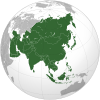
States with limited recognition Dependencies and
Special Administrative RegionsAustraliaChina (PRC)United KingdomMiddle East Countries and territories Other topics Countries and territories of the Mediterranean Sea World Trade Organization System - Accession and membership
- Appellate Body
- Dispute Settlement Body
- International Trade Centre
- Chronology of key events
Issues Agreements - General Agreement on Tariffs and Trade
- Agriculture
- Sanitary and Phytosanitary Measures
- Technical Barriers to Trade
- Trade Related Investment Measures
- Trade in Services
- Trade-Related Aspects of Intellectual Property Rights
- Government Procurement
- Information Technology
- Marrakech Agreement
- Doha Declaration
Ministerial Conferences - 1st (1996)
- 2nd (1998)
- 3rd (1999)
- 4th (2001)
- 5th (2003)
- 6th (2005)
- 7th (2009)
People - Pascal Lamy (Director-General)
- Supachai Panitchpakdi (Former Director-General)
- Deputy Directors-General:
- Alejandro Jara
- Valentine Rugwabiza
- Harsha Singh
- Rufus Yerxa
Members - Albania
- Algeria
- Angola
- Antigua and Barbuda
- Argentina
- Armenia
- Australia
- Bahrain
- Bangladesh
- Barbados
- Belize
- Benin
- Bolivia
- Botswana
- Brazil
- Brunei
- Burkina Faso
- Burma
- Burundi
- Cambodia
- Cameroon
- Canada
- Cape Verde
- Central African Republic
- Chad
- Chile
- PR China
- Colombia
- Democratic Republic of the Congo
- Republic of the Congo
- Costa Rica
- Côte d'Ivoire
- Croatia
- Cuba
- Djibouti
- Dominica
- Dominican Republic
- Ecuador
- Egypt
- El Salvador
- European Union¹
- Fiji
- Gabon
- The Gambia
- Georgia
- Ghana
- Grenada
- Guatemala
- Guinea
- Guinea-Bissau
- Guyana
- Haiti
- Honduras
- Hong Kong²
- Iceland
- India
- Indonesia
- Israel
- Jamaica
- Japan
- Jordan
- Kenya
- South Korea
- Kuwait
- Kyrgyzstan
- Lesotho
- Liechtenstein
- Macau²
- Macedonia
- Madagascar
- Malawi
- Malaysia
- Maldives
- Mali
- Mauritania
- Mauritius
- Mexico
- Moldova
- Mongolia
- Morocco
- Mozambique
- Namibia
- Nepal
- New Zealand
- Nicaragua
- Niger
- Nigeria
- Norway
- Oman
- Pakistan
- Panama
- Papua New Guinea
- Paraguay
- Peru
- Philippines
- Qatar
- Rwanda
- St. Kitts and Nevis
- St. Lucia
- St. Vincent and the Grenadines
- Saudi Arabia
- Senegal
- Sierra Leone
- Singapore
- Solomon Islands
- South Africa
- Sri Lanka
- Suriname
- Swaziland
- Switzerland
- Separate Customs Territory of Taiwan, Penghu, Kinmen, and Matsu³
- Tanzania
- Thailand
- Togo
- Tonga
- Trinidad and Tobago
- Tunisia
- Turkey
- Uganda
- Ukraine
- United Arab Emirates
- United States
- Uruguay
- Venezuela
- Vietnam
- Zambia
- Zimbabwe
1. All twenty-seven member states of the European Union are also members of the WTO in their own right:
- Austria
- Belgium
- Bulgaria
- Cyprus
- Czech Republic
- Denmark
- Estonia
- Finland
- France
- Germany
- Greece
- Hungary
- Ireland
- Italy
- Latvia
- Lithuania
- Luxembourg
- Malta
- Netherlands
- Poland
- Portugal
- Romania
- Slovakia
- Slovenia
- Spain
- Sweden
- United Kingdom
2. Special administrative region of the People's Republic of China
3. Designated name for the Republic of China (commonly known as Taiwan)National personifications - Argentina
- Effigies of Argentina
- Armenia
- Mother Armenia
- Brazil
- Efígie da República
- Cambodia
- Preah Thong and Neang Neak
- Canada
- Johnny Canuck
- Finland
- Finnish Maiden (Suomi-neito)
- France
- Marianne
- Georgia
- Kartlis Deda
- Germany
- Deutscher Michel
- Germania
- Greece
- Athena
- "Greece" of Delacroix
- Iceland
- Lady of the Mountain
- India
- Bharat Mata
- Indonesia
- Ibu Pertiwi
- Ireland
- Ériu
- Hibernia
- Kathleen Ni Houlihan
- Israel
- Srulik
- Italy
- Italia Turrita
- Japan
- Amaterasu
- Malaysia
- Ibu Pertiwi
- Netherlands
- Netherlands Maiden
- New Zealand
- Zealandia
- Norway
- Ola Nordmann
- Pakistan
- Pak Watan
- Philippines
- Juan dela Cruz
- Maria Clara
- Poland
- Polonia
- Portugal
- Efígie da República
- Zé Povinho
- Russia
- Mother Russia
- Spain
- Hispania
- Sweden
- Mother Svea
- Switzerland
- Helvetia
- Ukraine
- Cossack Mamay
- United Kingdom
- Britannia
- John Bull
- Dame Wales
Categories:- Aliyah
- Israel
- Arabic-speaking countries and territories
- Countries bordering the Red Sea
- Eastern Mediterranean countries
- Hebrew words and phrases
- Levant
- Liberal democracies
- Member states of the Union for the Mediterranean
- Member states of the United Nations
- Middle Eastern countries
- Near Eastern countries
- Republics
- States and territories established in 1948
- Zionism
Wikimedia Foundation. 2010.

